How food quality, price and service quality affects customer satisfaction: A case study on Bistro Restaurant in St. James Court, A Taj Hotel, London
VerifiedAdded on 2022/11/26
|38
|9669
|433
AI Summary
This dissertation explores the impact of food quality, price, and service quality on customer satisfaction in the hospitality industry. It focuses on a case study of Bistro Restaurant in St. James Court, A Taj Hotel, London. The research aims to understand the concepts of food quality and service quality and analyze their importance in customer satisfaction. The study includes a literature review, research methodology, data analysis, and recommendations for improving customer satisfaction.
Contribute Materials
Your contribution can guide someone’s learning journey. Share your
documents today.
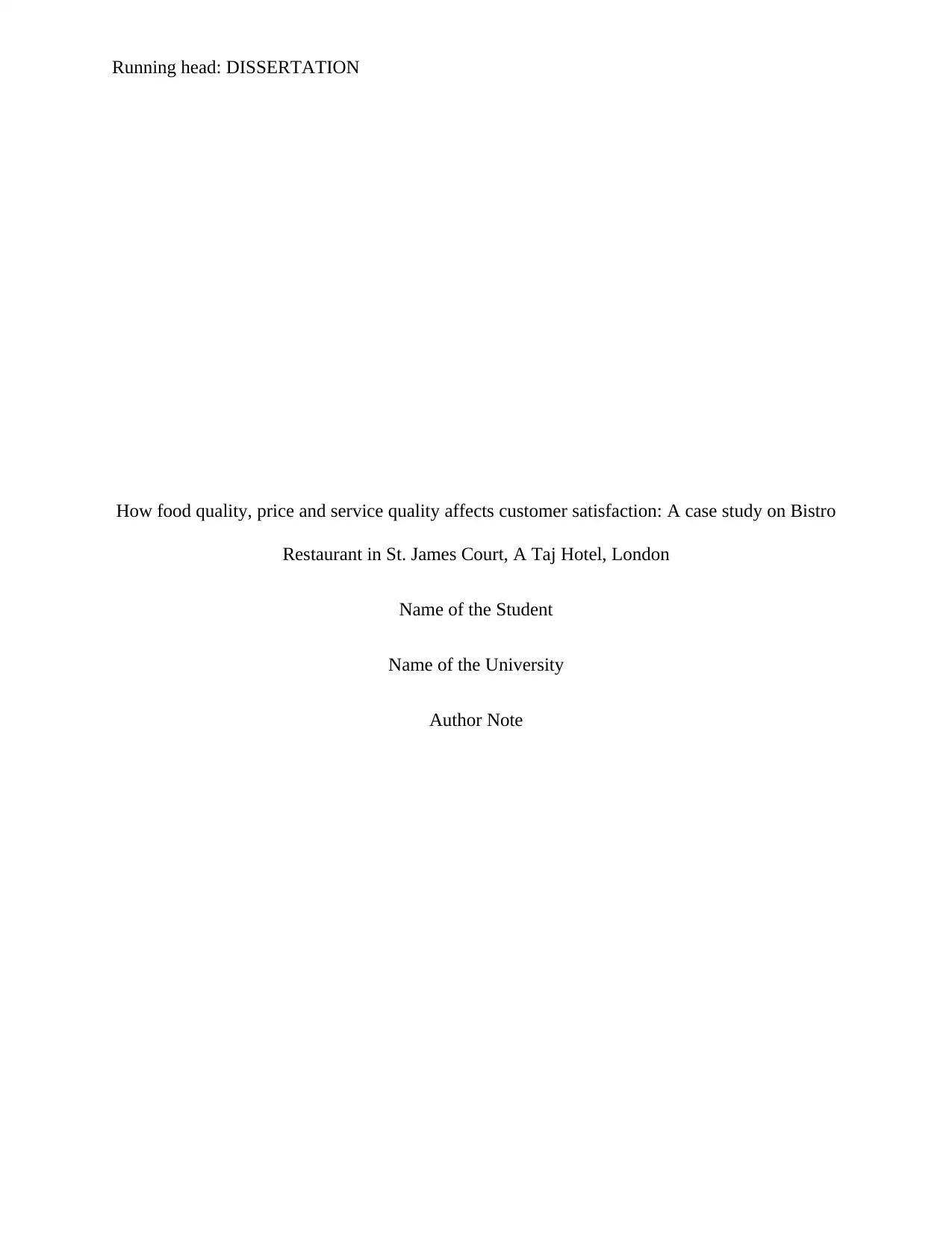
Running head: DISSERTATION
How food quality, price and service quality affects customer satisfaction: A case study on Bistro
Restaurant in St. James Court, A Taj Hotel, London
Name of the Student
Name of the University
Author Note
How food quality, price and service quality affects customer satisfaction: A case study on Bistro
Restaurant in St. James Court, A Taj Hotel, London
Name of the Student
Name of the University
Author Note
Secure Best Marks with AI Grader
Need help grading? Try our AI Grader for instant feedback on your assignments.
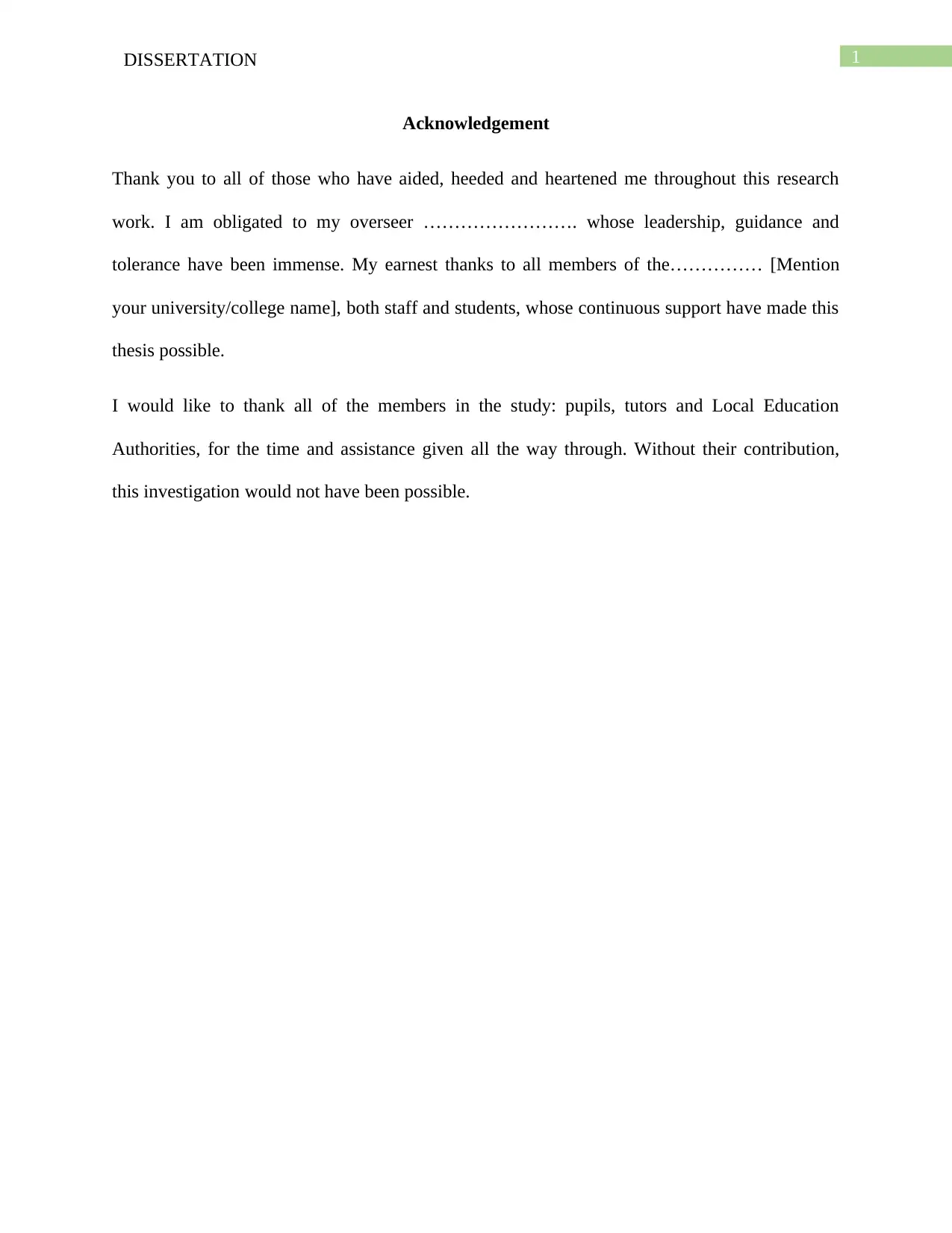
1DISSERTATION
Acknowledgement
Thank you to all of those who have aided, heeded and heartened me throughout this research
work. I am obligated to my overseer ……………………. whose leadership, guidance and
tolerance have been immense. My earnest thanks to all members of the…………… [Mention
your university/college name], both staff and students, whose continuous support have made this
thesis possible.
I would like to thank all of the members in the study: pupils, tutors and Local Education
Authorities, for the time and assistance given all the way through. Without their contribution,
this investigation would not have been possible.
Acknowledgement
Thank you to all of those who have aided, heeded and heartened me throughout this research
work. I am obligated to my overseer ……………………. whose leadership, guidance and
tolerance have been immense. My earnest thanks to all members of the…………… [Mention
your university/college name], both staff and students, whose continuous support have made this
thesis possible.
I would like to thank all of the members in the study: pupils, tutors and Local Education
Authorities, for the time and assistance given all the way through. Without their contribution,
this investigation would not have been possible.
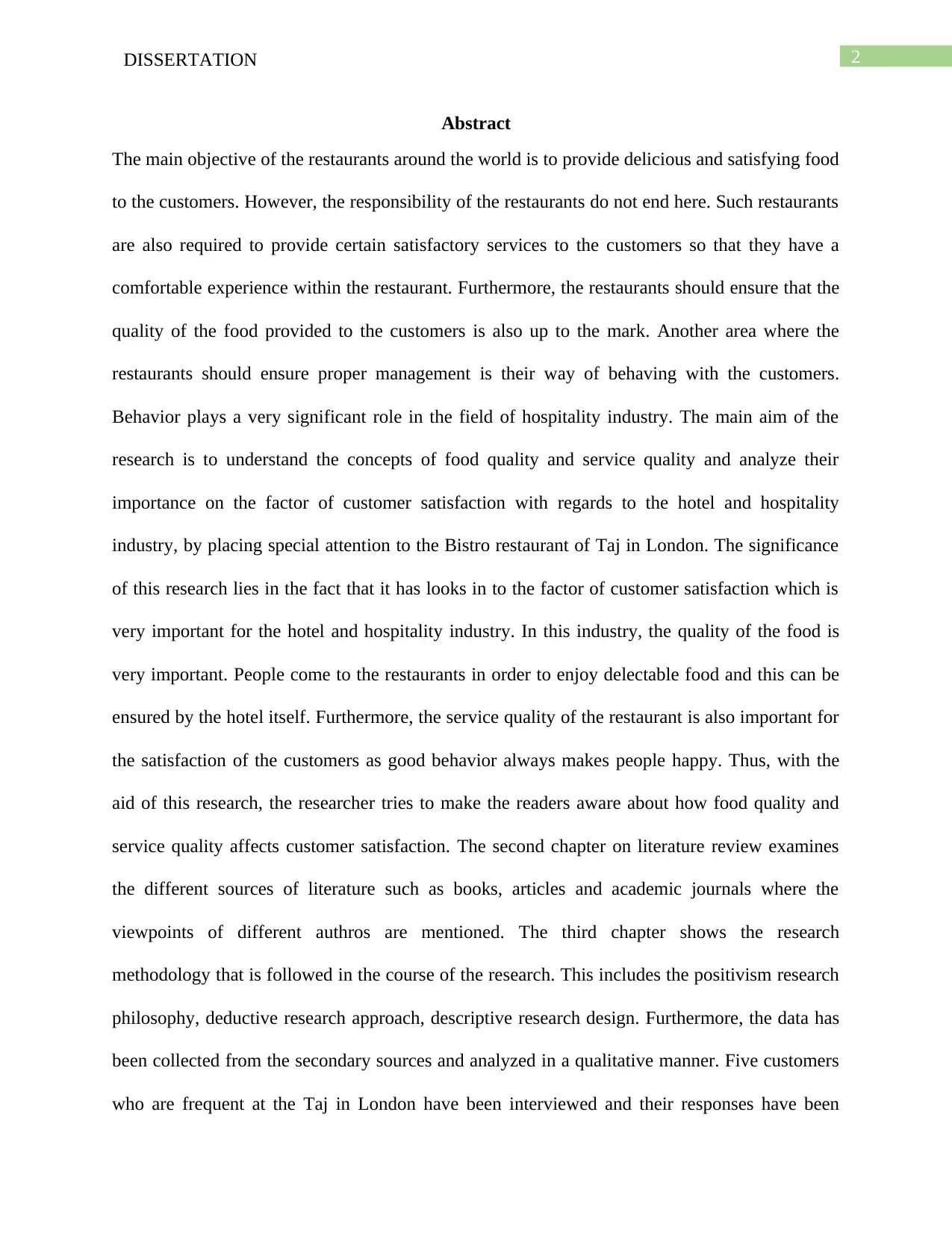
2DISSERTATION
Abstract
The main objective of the restaurants around the world is to provide delicious and satisfying food
to the customers. However, the responsibility of the restaurants do not end here. Such restaurants
are also required to provide certain satisfactory services to the customers so that they have a
comfortable experience within the restaurant. Furthermore, the restaurants should ensure that the
quality of the food provided to the customers is also up to the mark. Another area where the
restaurants should ensure proper management is their way of behaving with the customers.
Behavior plays a very significant role in the field of hospitality industry. The main aim of the
research is to understand the concepts of food quality and service quality and analyze their
importance on the factor of customer satisfaction with regards to the hotel and hospitality
industry, by placing special attention to the Bistro restaurant of Taj in London. The significance
of this research lies in the fact that it has looks in to the factor of customer satisfaction which is
very important for the hotel and hospitality industry. In this industry, the quality of the food is
very important. People come to the restaurants in order to enjoy delectable food and this can be
ensured by the hotel itself. Furthermore, the service quality of the restaurant is also important for
the satisfaction of the customers as good behavior always makes people happy. Thus, with the
aid of this research, the researcher tries to make the readers aware about how food quality and
service quality affects customer satisfaction. The second chapter on literature review examines
the different sources of literature such as books, articles and academic journals where the
viewpoints of different authros are mentioned. The third chapter shows the research
methodology that is followed in the course of the research. This includes the positivism research
philosophy, deductive research approach, descriptive research design. Furthermore, the data has
been collected from the secondary sources and analyzed in a qualitative manner. Five customers
who are frequent at the Taj in London have been interviewed and their responses have been
Abstract
The main objective of the restaurants around the world is to provide delicious and satisfying food
to the customers. However, the responsibility of the restaurants do not end here. Such restaurants
are also required to provide certain satisfactory services to the customers so that they have a
comfortable experience within the restaurant. Furthermore, the restaurants should ensure that the
quality of the food provided to the customers is also up to the mark. Another area where the
restaurants should ensure proper management is their way of behaving with the customers.
Behavior plays a very significant role in the field of hospitality industry. The main aim of the
research is to understand the concepts of food quality and service quality and analyze their
importance on the factor of customer satisfaction with regards to the hotel and hospitality
industry, by placing special attention to the Bistro restaurant of Taj in London. The significance
of this research lies in the fact that it has looks in to the factor of customer satisfaction which is
very important for the hotel and hospitality industry. In this industry, the quality of the food is
very important. People come to the restaurants in order to enjoy delectable food and this can be
ensured by the hotel itself. Furthermore, the service quality of the restaurant is also important for
the satisfaction of the customers as good behavior always makes people happy. Thus, with the
aid of this research, the researcher tries to make the readers aware about how food quality and
service quality affects customer satisfaction. The second chapter on literature review examines
the different sources of literature such as books, articles and academic journals where the
viewpoints of different authros are mentioned. The third chapter shows the research
methodology that is followed in the course of the research. This includes the positivism research
philosophy, deductive research approach, descriptive research design. Furthermore, the data has
been collected from the secondary sources and analyzed in a qualitative manner. Five customers
who are frequent at the Taj in London have been interviewed and their responses have been

3DISSERTATION
analyzed in the fourth chapter. The fifth chapter is the concluding chapter which provides certain
recommendation in order to maintain the satisfaction of the customers.
analyzed in the fourth chapter. The fifth chapter is the concluding chapter which provides certain
recommendation in order to maintain the satisfaction of the customers.
Secure Best Marks with AI Grader
Need help grading? Try our AI Grader for instant feedback on your assignments.
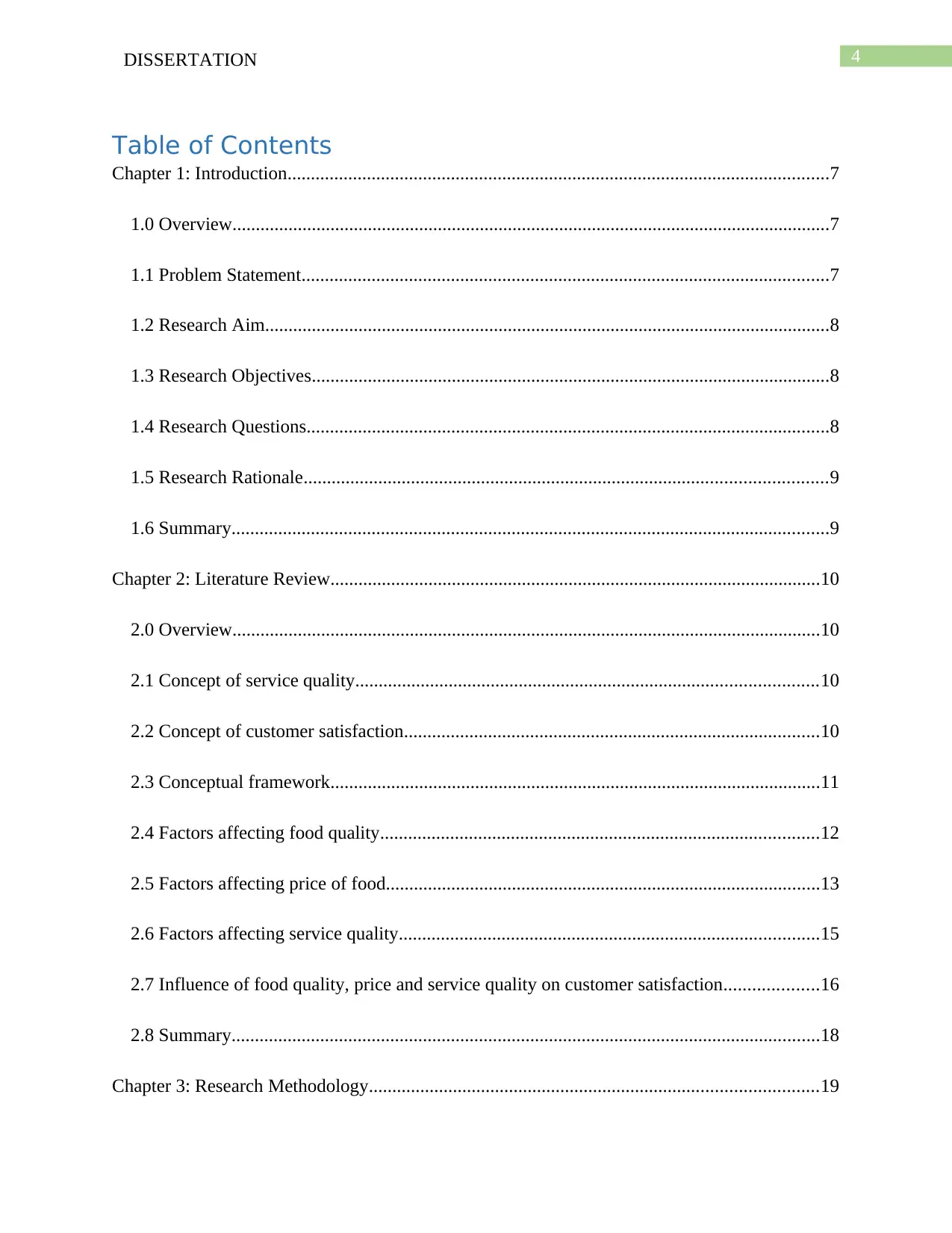
4DISSERTATION
Table of Contents
Chapter 1: Introduction....................................................................................................................7
1.0 Overview................................................................................................................................7
1.1 Problem Statement.................................................................................................................7
1.2 Research Aim.........................................................................................................................8
1.3 Research Objectives...............................................................................................................8
1.4 Research Questions................................................................................................................8
1.5 Research Rationale................................................................................................................9
1.6 Summary................................................................................................................................9
Chapter 2: Literature Review.........................................................................................................10
2.0 Overview..............................................................................................................................10
2.1 Concept of service quality...................................................................................................10
2.2 Concept of customer satisfaction.........................................................................................10
2.3 Conceptual framework.........................................................................................................11
2.4 Factors affecting food quality..............................................................................................12
2.5 Factors affecting price of food.............................................................................................13
2.6 Factors affecting service quality..........................................................................................15
2.7 Influence of food quality, price and service quality on customer satisfaction....................16
2.8 Summary..............................................................................................................................18
Chapter 3: Research Methodology................................................................................................19
Table of Contents
Chapter 1: Introduction....................................................................................................................7
1.0 Overview................................................................................................................................7
1.1 Problem Statement.................................................................................................................7
1.2 Research Aim.........................................................................................................................8
1.3 Research Objectives...............................................................................................................8
1.4 Research Questions................................................................................................................8
1.5 Research Rationale................................................................................................................9
1.6 Summary................................................................................................................................9
Chapter 2: Literature Review.........................................................................................................10
2.0 Overview..............................................................................................................................10
2.1 Concept of service quality...................................................................................................10
2.2 Concept of customer satisfaction.........................................................................................10
2.3 Conceptual framework.........................................................................................................11
2.4 Factors affecting food quality..............................................................................................12
2.5 Factors affecting price of food.............................................................................................13
2.6 Factors affecting service quality..........................................................................................15
2.7 Influence of food quality, price and service quality on customer satisfaction....................16
2.8 Summary..............................................................................................................................18
Chapter 3: Research Methodology................................................................................................19
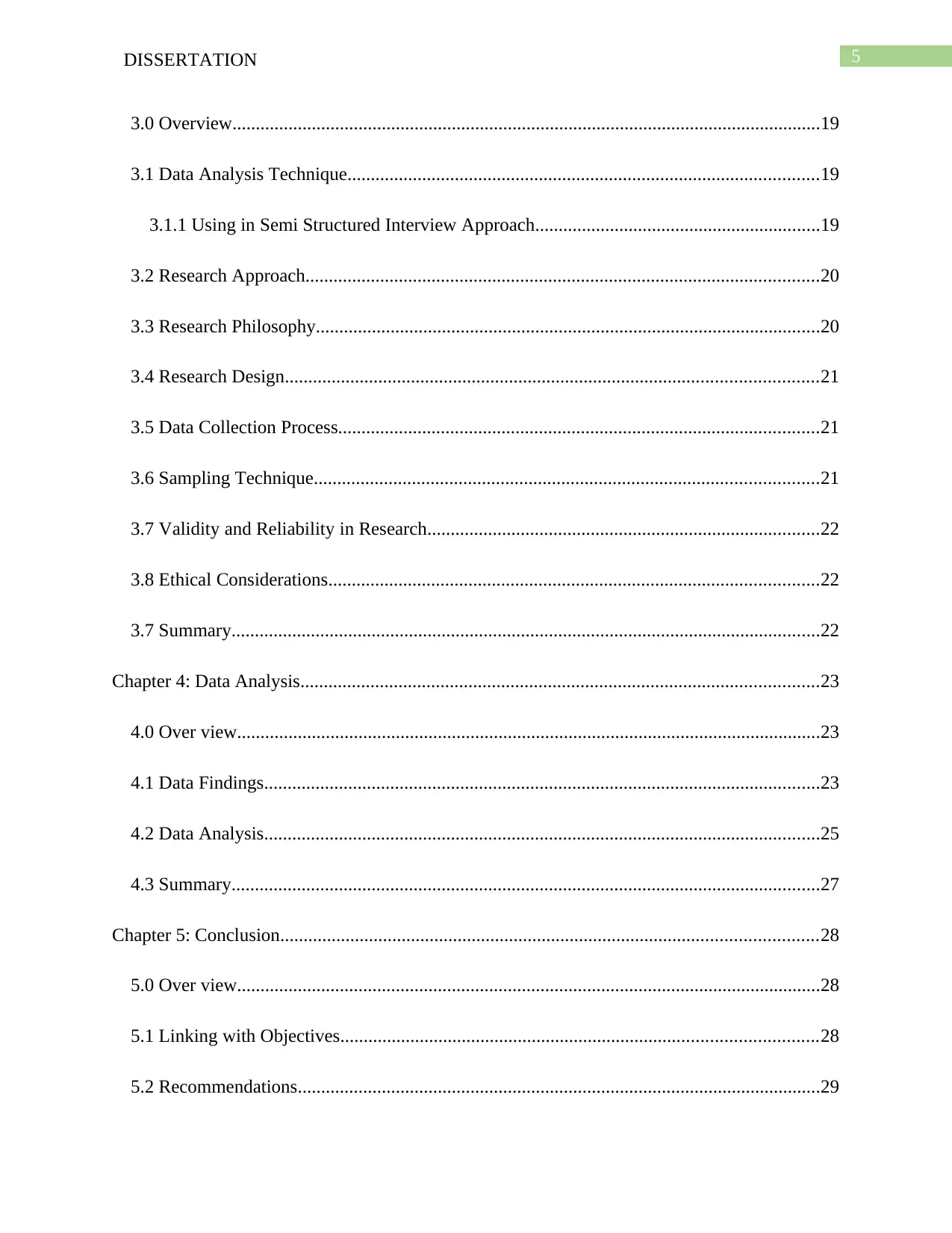
5DISSERTATION
3.0 Overview..............................................................................................................................19
3.1 Data Analysis Technique.....................................................................................................19
3.1.1 Using in Semi Structured Interview Approach.............................................................19
3.2 Research Approach..............................................................................................................20
3.3 Research Philosophy............................................................................................................20
3.4 Research Design..................................................................................................................21
3.5 Data Collection Process.......................................................................................................21
3.6 Sampling Technique............................................................................................................21
3.7 Validity and Reliability in Research....................................................................................22
3.8 Ethical Considerations.........................................................................................................22
3.7 Summary..............................................................................................................................22
Chapter 4: Data Analysis...............................................................................................................23
4.0 Over view.............................................................................................................................23
4.1 Data Findings.......................................................................................................................23
4.2 Data Analysis.......................................................................................................................25
4.3 Summary..............................................................................................................................27
Chapter 5: Conclusion...................................................................................................................28
5.0 Over view.............................................................................................................................28
5.1 Linking with Objectives......................................................................................................28
5.2 Recommendations................................................................................................................29
3.0 Overview..............................................................................................................................19
3.1 Data Analysis Technique.....................................................................................................19
3.1.1 Using in Semi Structured Interview Approach.............................................................19
3.2 Research Approach..............................................................................................................20
3.3 Research Philosophy............................................................................................................20
3.4 Research Design..................................................................................................................21
3.5 Data Collection Process.......................................................................................................21
3.6 Sampling Technique............................................................................................................21
3.7 Validity and Reliability in Research....................................................................................22
3.8 Ethical Considerations.........................................................................................................22
3.7 Summary..............................................................................................................................22
Chapter 4: Data Analysis...............................................................................................................23
4.0 Over view.............................................................................................................................23
4.1 Data Findings.......................................................................................................................23
4.2 Data Analysis.......................................................................................................................25
4.3 Summary..............................................................................................................................27
Chapter 5: Conclusion...................................................................................................................28
5.0 Over view.............................................................................................................................28
5.1 Linking with Objectives......................................................................................................28
5.2 Recommendations................................................................................................................29

6DISSERTATION
5.3 Scope of Future Research....................................................................................................29
References:....................................................................................................................................30
Appendix........................................................................................................................................37
Appendix 1: Interview Schedule...............................................................................................37
5.3 Scope of Future Research....................................................................................................29
References:....................................................................................................................................30
Appendix........................................................................................................................................37
Appendix 1: Interview Schedule...............................................................................................37
Paraphrase This Document
Need a fresh take? Get an instant paraphrase of this document with our AI Paraphraser
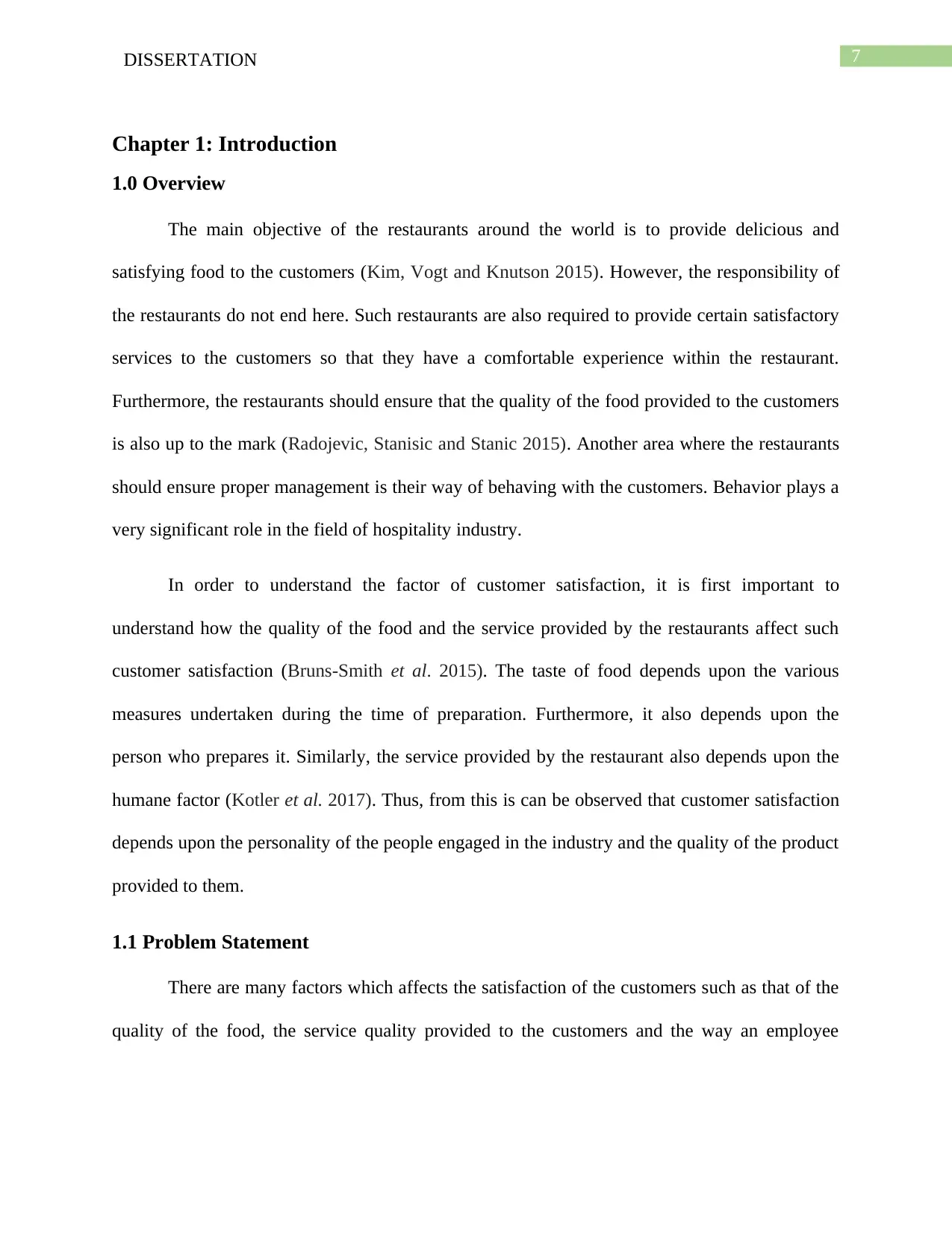
7DISSERTATION
Chapter 1: Introduction
1.0 Overview
The main objective of the restaurants around the world is to provide delicious and
satisfying food to the customers (Kim, Vogt and Knutson 2015). However, the responsibility of
the restaurants do not end here. Such restaurants are also required to provide certain satisfactory
services to the customers so that they have a comfortable experience within the restaurant.
Furthermore, the restaurants should ensure that the quality of the food provided to the customers
is also up to the mark (Radojevic, Stanisic and Stanic 2015). Another area where the restaurants
should ensure proper management is their way of behaving with the customers. Behavior plays a
very significant role in the field of hospitality industry.
In order to understand the factor of customer satisfaction, it is first important to
understand how the quality of the food and the service provided by the restaurants affect such
customer satisfaction (Bruns-Smith et al. 2015). The taste of food depends upon the various
measures undertaken during the time of preparation. Furthermore, it also depends upon the
person who prepares it. Similarly, the service provided by the restaurant also depends upon the
humane factor (Kotler et al. 2017). Thus, from this is can be observed that customer satisfaction
depends upon the personality of the people engaged in the industry and the quality of the product
provided to them.
1.1 Problem Statement
There are many factors which affects the satisfaction of the customers such as that of the
quality of the food, the service quality provided to the customers and the way an employee
Chapter 1: Introduction
1.0 Overview
The main objective of the restaurants around the world is to provide delicious and
satisfying food to the customers (Kim, Vogt and Knutson 2015). However, the responsibility of
the restaurants do not end here. Such restaurants are also required to provide certain satisfactory
services to the customers so that they have a comfortable experience within the restaurant.
Furthermore, the restaurants should ensure that the quality of the food provided to the customers
is also up to the mark (Radojevic, Stanisic and Stanic 2015). Another area where the restaurants
should ensure proper management is their way of behaving with the customers. Behavior plays a
very significant role in the field of hospitality industry.
In order to understand the factor of customer satisfaction, it is first important to
understand how the quality of the food and the service provided by the restaurants affect such
customer satisfaction (Bruns-Smith et al. 2015). The taste of food depends upon the various
measures undertaken during the time of preparation. Furthermore, it also depends upon the
person who prepares it. Similarly, the service provided by the restaurant also depends upon the
humane factor (Kotler et al. 2017). Thus, from this is can be observed that customer satisfaction
depends upon the personality of the people engaged in the industry and the quality of the product
provided to them.
1.1 Problem Statement
There are many factors which affects the satisfaction of the customers such as that of the
quality of the food, the service quality provided to the customers and the way an employee
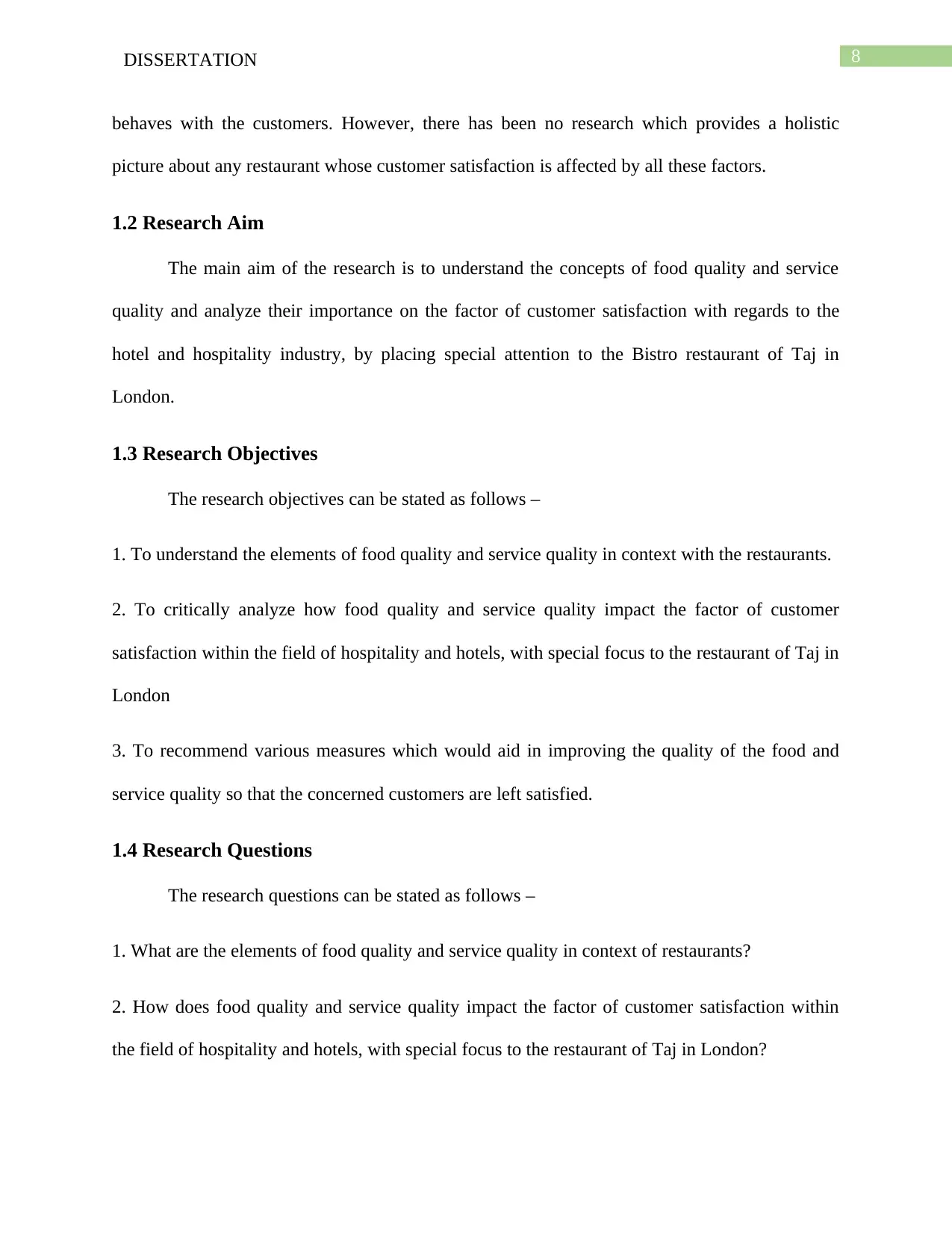
8DISSERTATION
behaves with the customers. However, there has been no research which provides a holistic
picture about any restaurant whose customer satisfaction is affected by all these factors.
1.2 Research Aim
The main aim of the research is to understand the concepts of food quality and service
quality and analyze their importance on the factor of customer satisfaction with regards to the
hotel and hospitality industry, by placing special attention to the Bistro restaurant of Taj in
London.
1.3 Research Objectives
The research objectives can be stated as follows –
1. To understand the elements of food quality and service quality in context with the restaurants.
2. To critically analyze how food quality and service quality impact the factor of customer
satisfaction within the field of hospitality and hotels, with special focus to the restaurant of Taj in
London
3. To recommend various measures which would aid in improving the quality of the food and
service quality so that the concerned customers are left satisfied.
1.4 Research Questions
The research questions can be stated as follows –
1. What are the elements of food quality and service quality in context of restaurants?
2. How does food quality and service quality impact the factor of customer satisfaction within
the field of hospitality and hotels, with special focus to the restaurant of Taj in London?
behaves with the customers. However, there has been no research which provides a holistic
picture about any restaurant whose customer satisfaction is affected by all these factors.
1.2 Research Aim
The main aim of the research is to understand the concepts of food quality and service
quality and analyze their importance on the factor of customer satisfaction with regards to the
hotel and hospitality industry, by placing special attention to the Bistro restaurant of Taj in
London.
1.3 Research Objectives
The research objectives can be stated as follows –
1. To understand the elements of food quality and service quality in context with the restaurants.
2. To critically analyze how food quality and service quality impact the factor of customer
satisfaction within the field of hospitality and hotels, with special focus to the restaurant of Taj in
London
3. To recommend various measures which would aid in improving the quality of the food and
service quality so that the concerned customers are left satisfied.
1.4 Research Questions
The research questions can be stated as follows –
1. What are the elements of food quality and service quality in context of restaurants?
2. How does food quality and service quality impact the factor of customer satisfaction within
the field of hospitality and hotels, with special focus to the restaurant of Taj in London?
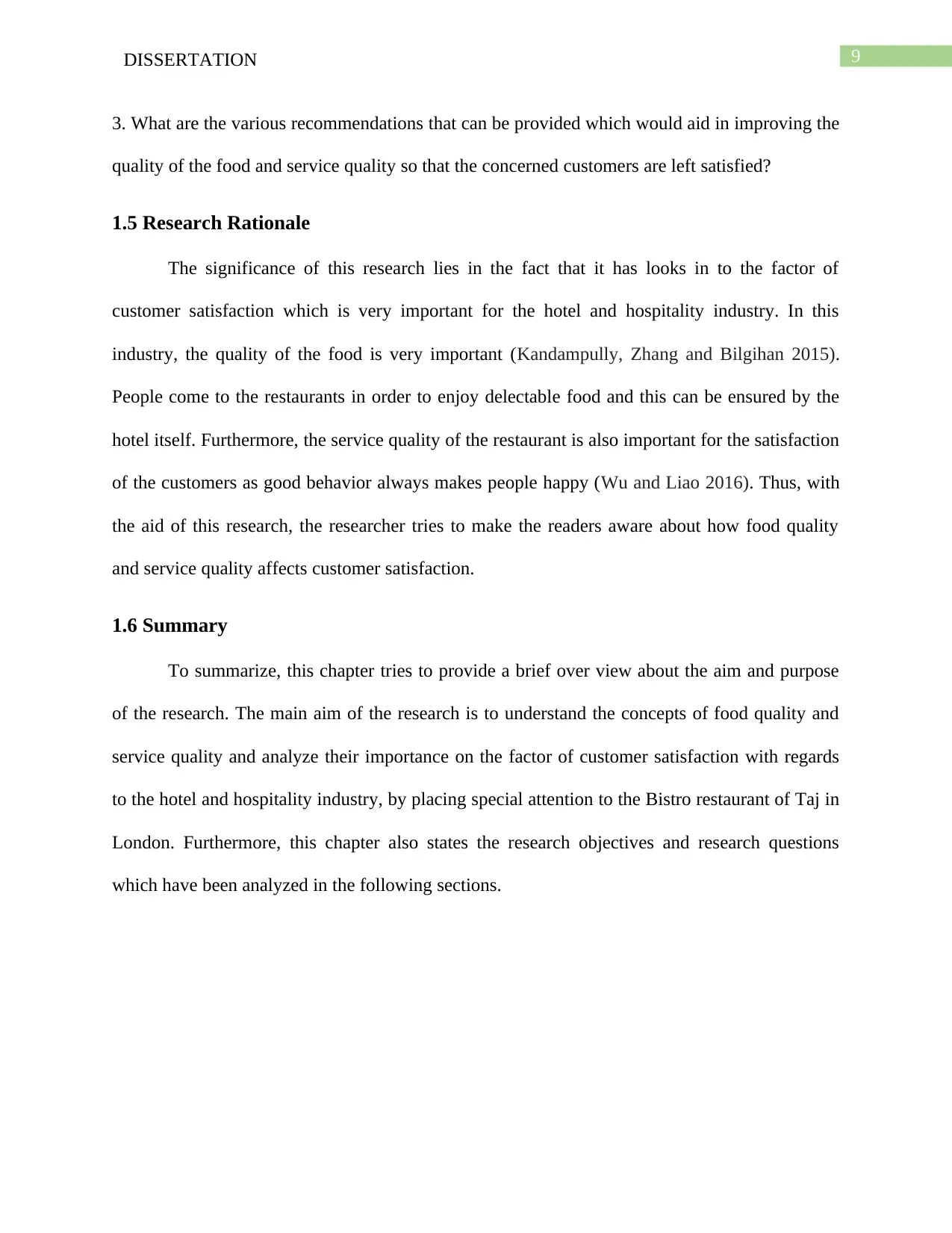
9DISSERTATION
3. What are the various recommendations that can be provided which would aid in improving the
quality of the food and service quality so that the concerned customers are left satisfied?
1.5 Research Rationale
The significance of this research lies in the fact that it has looks in to the factor of
customer satisfaction which is very important for the hotel and hospitality industry. In this
industry, the quality of the food is very important (Kandampully, Zhang and Bilgihan 2015).
People come to the restaurants in order to enjoy delectable food and this can be ensured by the
hotel itself. Furthermore, the service quality of the restaurant is also important for the satisfaction
of the customers as good behavior always makes people happy (Wu and Liao 2016). Thus, with
the aid of this research, the researcher tries to make the readers aware about how food quality
and service quality affects customer satisfaction.
1.6 Summary
To summarize, this chapter tries to provide a brief over view about the aim and purpose
of the research. The main aim of the research is to understand the concepts of food quality and
service quality and analyze their importance on the factor of customer satisfaction with regards
to the hotel and hospitality industry, by placing special attention to the Bistro restaurant of Taj in
London. Furthermore, this chapter also states the research objectives and research questions
which have been analyzed in the following sections.
3. What are the various recommendations that can be provided which would aid in improving the
quality of the food and service quality so that the concerned customers are left satisfied?
1.5 Research Rationale
The significance of this research lies in the fact that it has looks in to the factor of
customer satisfaction which is very important for the hotel and hospitality industry. In this
industry, the quality of the food is very important (Kandampully, Zhang and Bilgihan 2015).
People come to the restaurants in order to enjoy delectable food and this can be ensured by the
hotel itself. Furthermore, the service quality of the restaurant is also important for the satisfaction
of the customers as good behavior always makes people happy (Wu and Liao 2016). Thus, with
the aid of this research, the researcher tries to make the readers aware about how food quality
and service quality affects customer satisfaction.
1.6 Summary
To summarize, this chapter tries to provide a brief over view about the aim and purpose
of the research. The main aim of the research is to understand the concepts of food quality and
service quality and analyze their importance on the factor of customer satisfaction with regards
to the hotel and hospitality industry, by placing special attention to the Bistro restaurant of Taj in
London. Furthermore, this chapter also states the research objectives and research questions
which have been analyzed in the following sections.
Secure Best Marks with AI Grader
Need help grading? Try our AI Grader for instant feedback on your assignments.
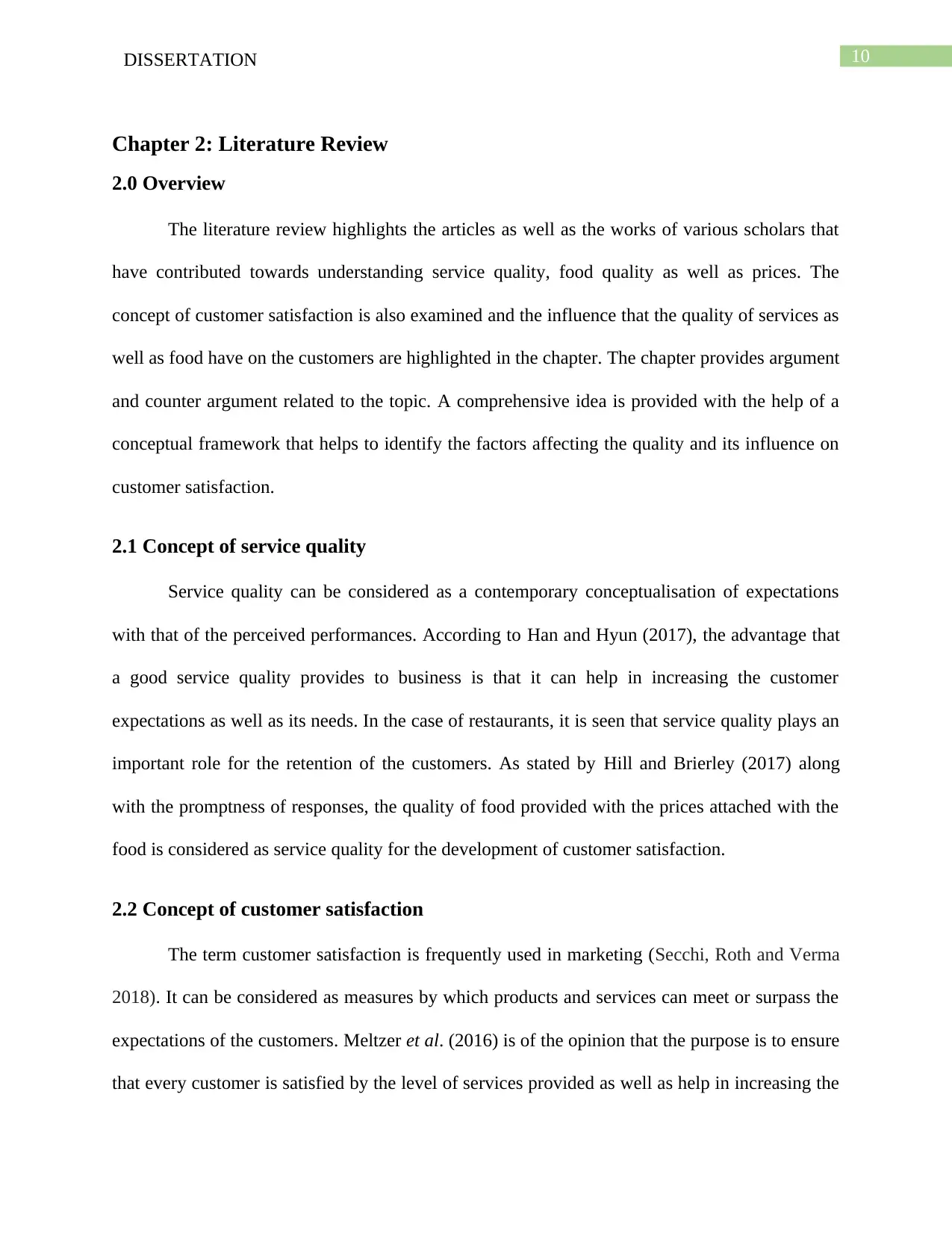
10DISSERTATION
Chapter 2: Literature Review
2.0 Overview
The literature review highlights the articles as well as the works of various scholars that
have contributed towards understanding service quality, food quality as well as prices. The
concept of customer satisfaction is also examined and the influence that the quality of services as
well as food have on the customers are highlighted in the chapter. The chapter provides argument
and counter argument related to the topic. A comprehensive idea is provided with the help of a
conceptual framework that helps to identify the factors affecting the quality and its influence on
customer satisfaction.
2.1 Concept of service quality
Service quality can be considered as a contemporary conceptualisation of expectations
with that of the perceived performances. According to Han and Hyun (2017), the advantage that
a good service quality provides to business is that it can help in increasing the customer
expectations as well as its needs. In the case of restaurants, it is seen that service quality plays an
important role for the retention of the customers. As stated by Hill and Brierley (2017) along
with the promptness of responses, the quality of food provided with the prices attached with the
food is considered as service quality for the development of customer satisfaction.
2.2 Concept of customer satisfaction
The term customer satisfaction is frequently used in marketing (Secchi, Roth and Verma
2018). It can be considered as measures by which products and services can meet or surpass the
expectations of the customers. Meltzer et al. (2016) is of the opinion that the purpose is to ensure
that every customer is satisfied by the level of services provided as well as help in increasing the
Chapter 2: Literature Review
2.0 Overview
The literature review highlights the articles as well as the works of various scholars that
have contributed towards understanding service quality, food quality as well as prices. The
concept of customer satisfaction is also examined and the influence that the quality of services as
well as food have on the customers are highlighted in the chapter. The chapter provides argument
and counter argument related to the topic. A comprehensive idea is provided with the help of a
conceptual framework that helps to identify the factors affecting the quality and its influence on
customer satisfaction.
2.1 Concept of service quality
Service quality can be considered as a contemporary conceptualisation of expectations
with that of the perceived performances. According to Han and Hyun (2017), the advantage that
a good service quality provides to business is that it can help in increasing the customer
expectations as well as its needs. In the case of restaurants, it is seen that service quality plays an
important role for the retention of the customers. As stated by Hill and Brierley (2017) along
with the promptness of responses, the quality of food provided with the prices attached with the
food is considered as service quality for the development of customer satisfaction.
2.2 Concept of customer satisfaction
The term customer satisfaction is frequently used in marketing (Secchi, Roth and Verma
2018). It can be considered as measures by which products and services can meet or surpass the
expectations of the customers. Meltzer et al. (2016) is of the opinion that the purpose is to ensure
that every customer is satisfied by the level of services provided as well as help in increasing the
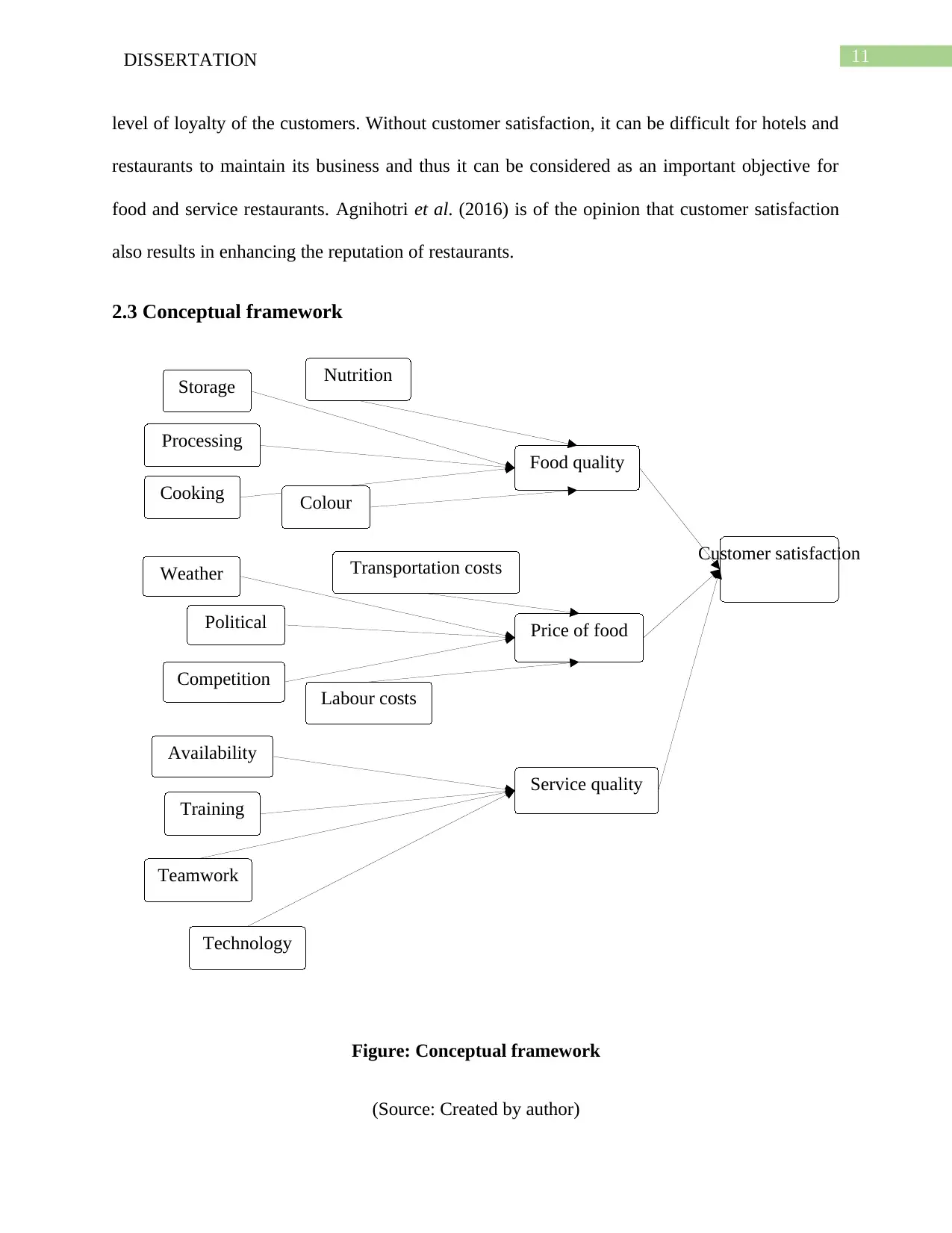
11DISSERTATION
Price of food
Customer satisfaction
Storage
Processing
Weather
Availability
Training
Food quality
Service quality
Cooking
Nutrition
Colour
Political
Competition
Labour costs
Transportation costs
Teamwork
Technology
level of loyalty of the customers. Without customer satisfaction, it can be difficult for hotels and
restaurants to maintain its business and thus it can be considered as an important objective for
food and service restaurants. Agnihotri et al. (2016) is of the opinion that customer satisfaction
also results in enhancing the reputation of restaurants.
2.3 Conceptual framework
Figure: Conceptual framework
(Source: Created by author)
Price of food
Customer satisfaction
Storage
Processing
Weather
Availability
Training
Food quality
Service quality
Cooking
Nutrition
Colour
Political
Competition
Labour costs
Transportation costs
Teamwork
Technology
level of loyalty of the customers. Without customer satisfaction, it can be difficult for hotels and
restaurants to maintain its business and thus it can be considered as an important objective for
food and service restaurants. Agnihotri et al. (2016) is of the opinion that customer satisfaction
also results in enhancing the reputation of restaurants.
2.3 Conceptual framework
Figure: Conceptual framework
(Source: Created by author)
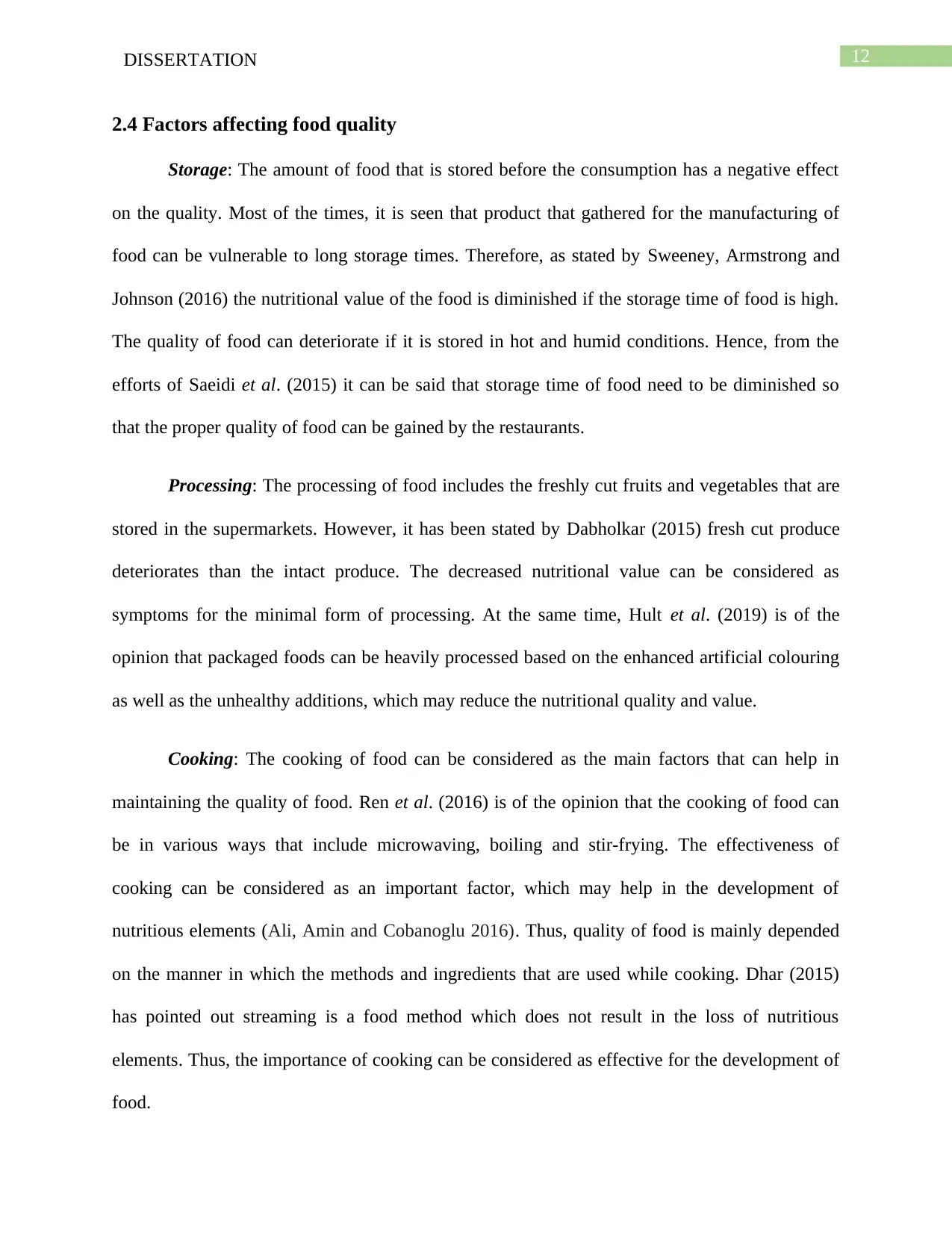
12DISSERTATION
2.4 Factors affecting food quality
Storage: The amount of food that is stored before the consumption has a negative effect
on the quality. Most of the times, it is seen that product that gathered for the manufacturing of
food can be vulnerable to long storage times. Therefore, as stated by Sweeney, Armstrong and
Johnson (2016) the nutritional value of the food is diminished if the storage time of food is high.
The quality of food can deteriorate if it is stored in hot and humid conditions. Hence, from the
efforts of Saeidi et al. (2015) it can be said that storage time of food need to be diminished so
that the proper quality of food can be gained by the restaurants.
Processing: The processing of food includes the freshly cut fruits and vegetables that are
stored in the supermarkets. However, it has been stated by Dabholkar (2015) fresh cut produce
deteriorates than the intact produce. The decreased nutritional value can be considered as
symptoms for the minimal form of processing. At the same time, Hult et al. (2019) is of the
opinion that packaged foods can be heavily processed based on the enhanced artificial colouring
as well as the unhealthy additions, which may reduce the nutritional quality and value.
Cooking: The cooking of food can be considered as the main factors that can help in
maintaining the quality of food. Ren et al. (2016) is of the opinion that the cooking of food can
be in various ways that include microwaving, boiling and stir-frying. The effectiveness of
cooking can be considered as an important factor, which may help in the development of
nutritious elements (Ali, Amin and Cobanoglu 2016). Thus, quality of food is mainly depended
on the manner in which the methods and ingredients that are used while cooking. Dhar (2015)
has pointed out streaming is a food method which does not result in the loss of nutritious
elements. Thus, the importance of cooking can be considered as effective for the development of
food.
2.4 Factors affecting food quality
Storage: The amount of food that is stored before the consumption has a negative effect
on the quality. Most of the times, it is seen that product that gathered for the manufacturing of
food can be vulnerable to long storage times. Therefore, as stated by Sweeney, Armstrong and
Johnson (2016) the nutritional value of the food is diminished if the storage time of food is high.
The quality of food can deteriorate if it is stored in hot and humid conditions. Hence, from the
efforts of Saeidi et al. (2015) it can be said that storage time of food need to be diminished so
that the proper quality of food can be gained by the restaurants.
Processing: The processing of food includes the freshly cut fruits and vegetables that are
stored in the supermarkets. However, it has been stated by Dabholkar (2015) fresh cut produce
deteriorates than the intact produce. The decreased nutritional value can be considered as
symptoms for the minimal form of processing. At the same time, Hult et al. (2019) is of the
opinion that packaged foods can be heavily processed based on the enhanced artificial colouring
as well as the unhealthy additions, which may reduce the nutritional quality and value.
Cooking: The cooking of food can be considered as the main factors that can help in
maintaining the quality of food. Ren et al. (2016) is of the opinion that the cooking of food can
be in various ways that include microwaving, boiling and stir-frying. The effectiveness of
cooking can be considered as an important factor, which may help in the development of
nutritious elements (Ali, Amin and Cobanoglu 2016). Thus, quality of food is mainly depended
on the manner in which the methods and ingredients that are used while cooking. Dhar (2015)
has pointed out streaming is a food method which does not result in the loss of nutritious
elements. Thus, the importance of cooking can be considered as effective for the development of
food.
Paraphrase This Document
Need a fresh take? Get an instant paraphrase of this document with our AI Paraphraser
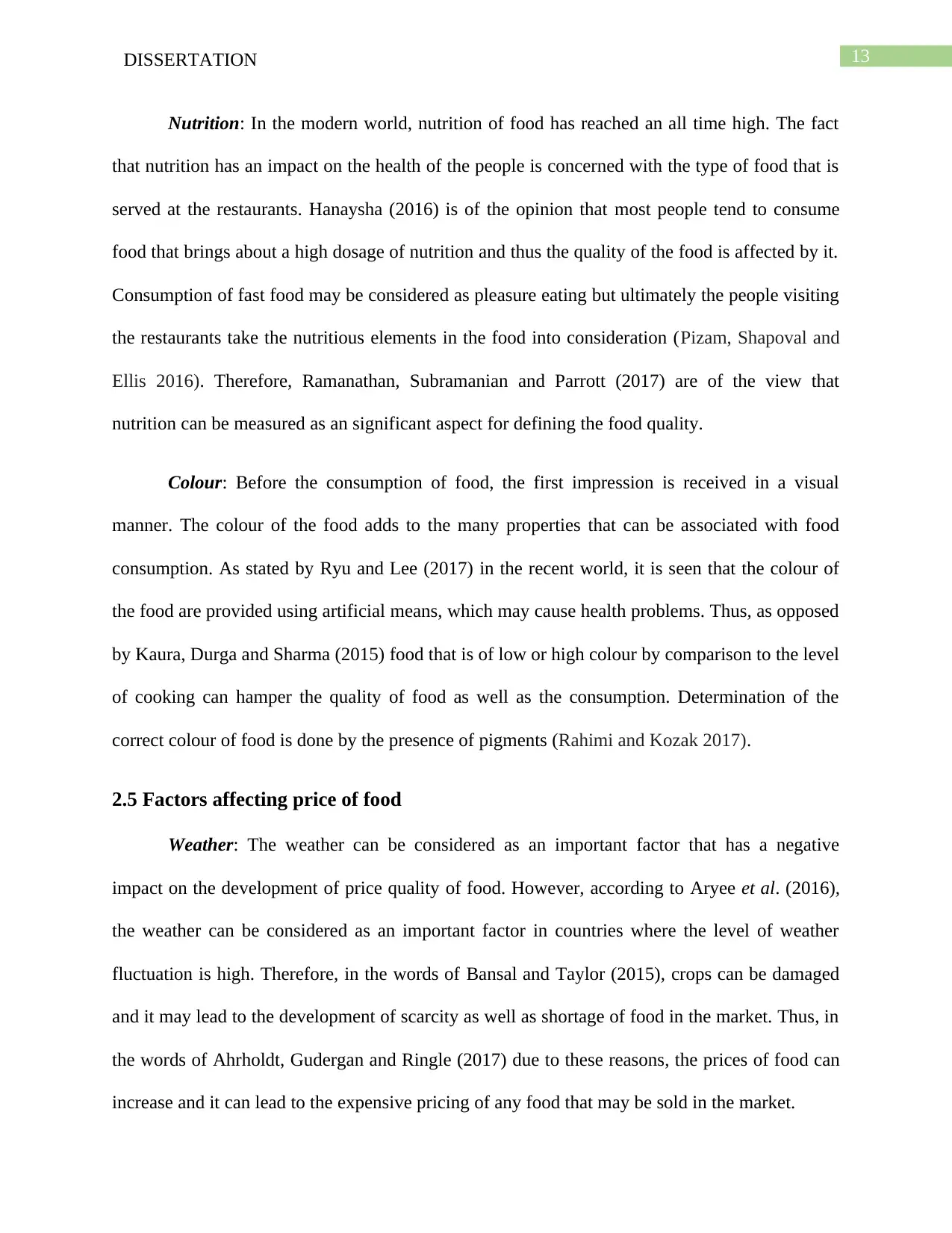
13DISSERTATION
Nutrition: In the modern world, nutrition of food has reached an all time high. The fact
that nutrition has an impact on the health of the people is concerned with the type of food that is
served at the restaurants. Hanaysha (2016) is of the opinion that most people tend to consume
food that brings about a high dosage of nutrition and thus the quality of the food is affected by it.
Consumption of fast food may be considered as pleasure eating but ultimately the people visiting
the restaurants take the nutritious elements in the food into consideration (Pizam, Shapoval and
Ellis 2016). Therefore, Ramanathan, Subramanian and Parrott (2017) are of the view that
nutrition can be measured as an significant aspect for defining the food quality.
Colour: Before the consumption of food, the first impression is received in a visual
manner. The colour of the food adds to the many properties that can be associated with food
consumption. As stated by Ryu and Lee (2017) in the recent world, it is seen that the colour of
the food are provided using artificial means, which may cause health problems. Thus, as opposed
by Kaura, Durga and Sharma (2015) food that is of low or high colour by comparison to the level
of cooking can hamper the quality of food as well as the consumption. Determination of the
correct colour of food is done by the presence of pigments (Rahimi and Kozak 2017).
2.5 Factors affecting price of food
Weather: The weather can be considered as an important factor that has a negative
impact on the development of price quality of food. However, according to Aryee et al. (2016),
the weather can be considered as an important factor in countries where the level of weather
fluctuation is high. Therefore, in the words of Bansal and Taylor (2015), crops can be damaged
and it may lead to the development of scarcity as well as shortage of food in the market. Thus, in
the words of Ahrholdt, Gudergan and Ringle (2017) due to these reasons, the prices of food can
increase and it can lead to the expensive pricing of any food that may be sold in the market.
Nutrition: In the modern world, nutrition of food has reached an all time high. The fact
that nutrition has an impact on the health of the people is concerned with the type of food that is
served at the restaurants. Hanaysha (2016) is of the opinion that most people tend to consume
food that brings about a high dosage of nutrition and thus the quality of the food is affected by it.
Consumption of fast food may be considered as pleasure eating but ultimately the people visiting
the restaurants take the nutritious elements in the food into consideration (Pizam, Shapoval and
Ellis 2016). Therefore, Ramanathan, Subramanian and Parrott (2017) are of the view that
nutrition can be measured as an significant aspect for defining the food quality.
Colour: Before the consumption of food, the first impression is received in a visual
manner. The colour of the food adds to the many properties that can be associated with food
consumption. As stated by Ryu and Lee (2017) in the recent world, it is seen that the colour of
the food are provided using artificial means, which may cause health problems. Thus, as opposed
by Kaura, Durga and Sharma (2015) food that is of low or high colour by comparison to the level
of cooking can hamper the quality of food as well as the consumption. Determination of the
correct colour of food is done by the presence of pigments (Rahimi and Kozak 2017).
2.5 Factors affecting price of food
Weather: The weather can be considered as an important factor that has a negative
impact on the development of price quality of food. However, according to Aryee et al. (2016),
the weather can be considered as an important factor in countries where the level of weather
fluctuation is high. Therefore, in the words of Bansal and Taylor (2015), crops can be damaged
and it may lead to the development of scarcity as well as shortage of food in the market. Thus, in
the words of Ahrholdt, Gudergan and Ringle (2017) due to these reasons, the prices of food can
increase and it can lead to the expensive pricing of any food that may be sold in the market.

14DISSERTATION
Political: The political factors that can be associated with the development of food prices
include understanding the political scenario of a country. Ahrholdt, Gudergan and Ringle (2017)
is of the opinion that the Government of country may be involved in restricting the prices of food
and ensure that the business of the restaurants does not diminish due to political entities. At the
same time, as stated by Kasiri et al. (2017) economic considerations are also taken into account,
which may have a negative impact on the pricing. The pricing may fluctuate if the economic
condition of a country is not stable. Thus, as stated by Hill and Brierley (2017) the price plays an
important role for the development of the political factors in the market as well as for food
quality.
Transportation costs: Agnihotri et al. (2016) are of the opinion that the transportation
costs are included in moving the food from one place to another. In the modern world, the
transportation costs can be applied if people at homes order the food. The delivery charges are
included in the food and this constitutes the high price of food that is usually demanded by the
customers (Rather and Sharma 2017). Hence, as pointed out by Izogo and Ogba (2015) that
lowering the transportation costs can help in lowering the price of food and with it can help in
gaining a competitive advantage. At the same time, Sorescu and Sorescu (2016) have opposed
the fact that transportation costs of food should not be included in the prices of food.
Labour costs: The labour costs include the costs that are incurred for preparing the food.
Every restaurant consists of personnel that are required for making the quality of food. At the
same time, according to Sengupta, Balaji and Krishnan (2015), job opportunities for the
preparation of food exists which also helps in increasing the labour costs of food. The wages
offered as well as the service tips are included as the labour costs and thus, food prices may
increase. Hence, Oh and Kim (2017) stated that it could be said that the labour costs promote
Political: The political factors that can be associated with the development of food prices
include understanding the political scenario of a country. Ahrholdt, Gudergan and Ringle (2017)
is of the opinion that the Government of country may be involved in restricting the prices of food
and ensure that the business of the restaurants does not diminish due to political entities. At the
same time, as stated by Kasiri et al. (2017) economic considerations are also taken into account,
which may have a negative impact on the pricing. The pricing may fluctuate if the economic
condition of a country is not stable. Thus, as stated by Hill and Brierley (2017) the price plays an
important role for the development of the political factors in the market as well as for food
quality.
Transportation costs: Agnihotri et al. (2016) are of the opinion that the transportation
costs are included in moving the food from one place to another. In the modern world, the
transportation costs can be applied if people at homes order the food. The delivery charges are
included in the food and this constitutes the high price of food that is usually demanded by the
customers (Rather and Sharma 2017). Hence, as pointed out by Izogo and Ogba (2015) that
lowering the transportation costs can help in lowering the price of food and with it can help in
gaining a competitive advantage. At the same time, Sorescu and Sorescu (2016) have opposed
the fact that transportation costs of food should not be included in the prices of food.
Labour costs: The labour costs include the costs that are incurred for preparing the food.
Every restaurant consists of personnel that are required for making the quality of food. At the
same time, according to Sengupta, Balaji and Krishnan (2015), job opportunities for the
preparation of food exists which also helps in increasing the labour costs of food. The wages
offered as well as the service tips are included as the labour costs and thus, food prices may
increase. Hence, Oh and Kim (2017) stated that it could be said that the labour costs promote

15DISSERTATION
negative effects on the services of food and thus, allow for the prices of food to increase in a
steady manner in the market.
Competition: The competition between two restaurants is high and thus, the prices of
food need to increase which can help in maintaining the level of competition in the market. At
the same time, Saeidi et al. (2015) stated that it could be said that competition between the
restaurants account for the development of high prices since profitability remains the main aim
of the restaurants. Thus, in the words of Ali (2016) it can be said that competition among
restaurants can have a negative impact on the development of competition as well as lead to
customer dissatisfaction due to the high price of the food.
2.6 Factors affecting service quality
Availability: The availability of service quality can be considered as an important quality
for restaurants. According to Chathoth et al. (2016), the fact that most of the services that are
provided are based on the nature of support provided by the employees makes it difficult for
service quality people to negotiate with the different customers. At the same time, from the
words of Bowen and Chen McCain (2015) it can be said that availability of services also account
for continuous communication with people that may have a negative impact on the development
of quality services in the restaurants.
Technology: Technology can be considered as a factor that positively affects the
development of service quality. In the words of Han and Hyun (2017), it can be seen that
technology plays a crucial role in the services since most of the employees aim to understand the
nature of technology that can be used for the development of services. At the same time, from
the words of Meltzer et al. (2019) it can be said that technology provides an overview of the
negative effects on the services of food and thus, allow for the prices of food to increase in a
steady manner in the market.
Competition: The competition between two restaurants is high and thus, the prices of
food need to increase which can help in maintaining the level of competition in the market. At
the same time, Saeidi et al. (2015) stated that it could be said that competition between the
restaurants account for the development of high prices since profitability remains the main aim
of the restaurants. Thus, in the words of Ali (2016) it can be said that competition among
restaurants can have a negative impact on the development of competition as well as lead to
customer dissatisfaction due to the high price of the food.
2.6 Factors affecting service quality
Availability: The availability of service quality can be considered as an important quality
for restaurants. According to Chathoth et al. (2016), the fact that most of the services that are
provided are based on the nature of support provided by the employees makes it difficult for
service quality people to negotiate with the different customers. At the same time, from the
words of Bowen and Chen McCain (2015) it can be said that availability of services also account
for continuous communication with people that may have a negative impact on the development
of quality services in the restaurants.
Technology: Technology can be considered as a factor that positively affects the
development of service quality. In the words of Han and Hyun (2017), it can be seen that
technology plays a crucial role in the services since most of the employees aim to understand the
nature of technology that can be used for the development of services. At the same time, from
the words of Meltzer et al. (2019) it can be said that technology provides an overview of the
Secure Best Marks with AI Grader
Need help grading? Try our AI Grader for instant feedback on your assignments.
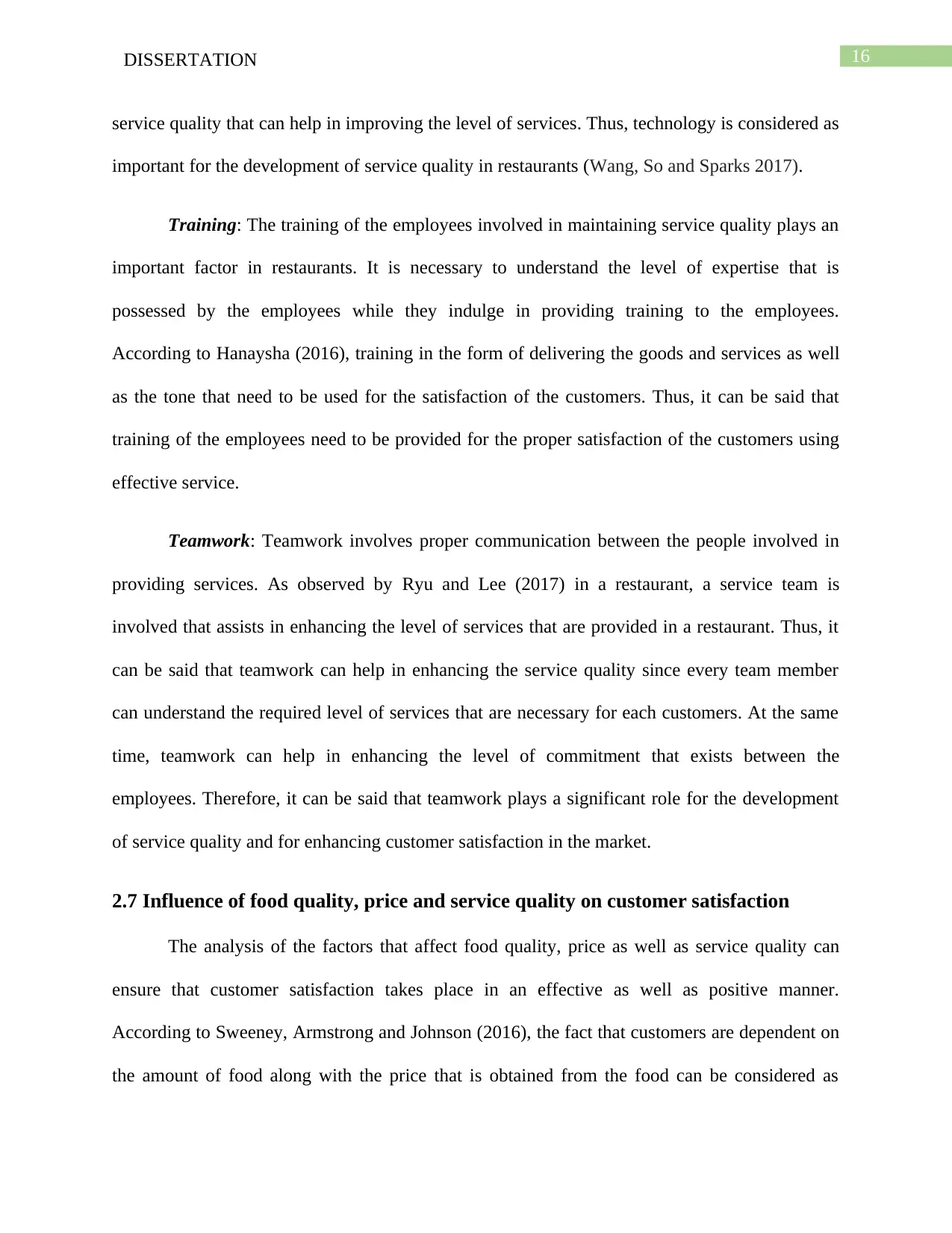
16DISSERTATION
service quality that can help in improving the level of services. Thus, technology is considered as
important for the development of service quality in restaurants (Wang, So and Sparks 2017).
Training: The training of the employees involved in maintaining service quality plays an
important factor in restaurants. It is necessary to understand the level of expertise that is
possessed by the employees while they indulge in providing training to the employees.
According to Hanaysha (2016), training in the form of delivering the goods and services as well
as the tone that need to be used for the satisfaction of the customers. Thus, it can be said that
training of the employees need to be provided for the proper satisfaction of the customers using
effective service.
Teamwork: Teamwork involves proper communication between the people involved in
providing services. As observed by Ryu and Lee (2017) in a restaurant, a service team is
involved that assists in enhancing the level of services that are provided in a restaurant. Thus, it
can be said that teamwork can help in enhancing the service quality since every team member
can understand the required level of services that are necessary for each customers. At the same
time, teamwork can help in enhancing the level of commitment that exists between the
employees. Therefore, it can be said that teamwork plays a significant role for the development
of service quality and for enhancing customer satisfaction in the market.
2.7 Influence of food quality, price and service quality on customer satisfaction
The analysis of the factors that affect food quality, price as well as service quality can
ensure that customer satisfaction takes place in an effective as well as positive manner.
According to Sweeney, Armstrong and Johnson (2016), the fact that customers are dependent on
the amount of food along with the price that is obtained from the food can be considered as
service quality that can help in improving the level of services. Thus, technology is considered as
important for the development of service quality in restaurants (Wang, So and Sparks 2017).
Training: The training of the employees involved in maintaining service quality plays an
important factor in restaurants. It is necessary to understand the level of expertise that is
possessed by the employees while they indulge in providing training to the employees.
According to Hanaysha (2016), training in the form of delivering the goods and services as well
as the tone that need to be used for the satisfaction of the customers. Thus, it can be said that
training of the employees need to be provided for the proper satisfaction of the customers using
effective service.
Teamwork: Teamwork involves proper communication between the people involved in
providing services. As observed by Ryu and Lee (2017) in a restaurant, a service team is
involved that assists in enhancing the level of services that are provided in a restaurant. Thus, it
can be said that teamwork can help in enhancing the service quality since every team member
can understand the required level of services that are necessary for each customers. At the same
time, teamwork can help in enhancing the level of commitment that exists between the
employees. Therefore, it can be said that teamwork plays a significant role for the development
of service quality and for enhancing customer satisfaction in the market.
2.7 Influence of food quality, price and service quality on customer satisfaction
The analysis of the factors that affect food quality, price as well as service quality can
ensure that customer satisfaction takes place in an effective as well as positive manner.
According to Sweeney, Armstrong and Johnson (2016), the fact that customers are dependent on
the amount of food along with the price that is obtained from the food can be considered as
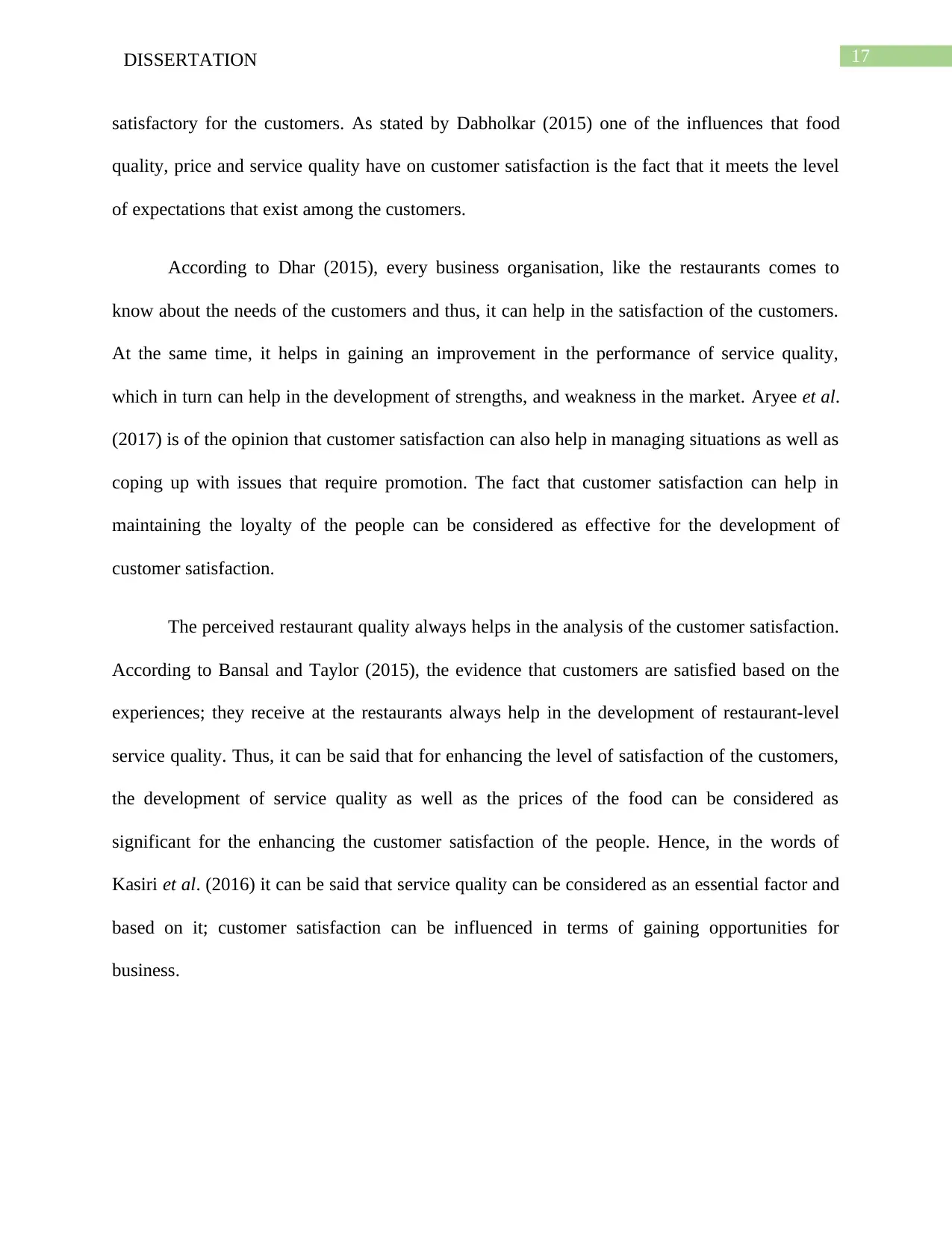
17DISSERTATION
satisfactory for the customers. As stated by Dabholkar (2015) one of the influences that food
quality, price and service quality have on customer satisfaction is the fact that it meets the level
of expectations that exist among the customers.
According to Dhar (2015), every business organisation, like the restaurants comes to
know about the needs of the customers and thus, it can help in the satisfaction of the customers.
At the same time, it helps in gaining an improvement in the performance of service quality,
which in turn can help in the development of strengths, and weakness in the market. Aryee et al.
(2017) is of the opinion that customer satisfaction can also help in managing situations as well as
coping up with issues that require promotion. The fact that customer satisfaction can help in
maintaining the loyalty of the people can be considered as effective for the development of
customer satisfaction.
The perceived restaurant quality always helps in the analysis of the customer satisfaction.
According to Bansal and Taylor (2015), the evidence that customers are satisfied based on the
experiences; they receive at the restaurants always help in the development of restaurant-level
service quality. Thus, it can be said that for enhancing the level of satisfaction of the customers,
the development of service quality as well as the prices of the food can be considered as
significant for the enhancing the customer satisfaction of the people. Hence, in the words of
Kasiri et al. (2016) it can be said that service quality can be considered as an essential factor and
based on it; customer satisfaction can be influenced in terms of gaining opportunities for
business.
satisfactory for the customers. As stated by Dabholkar (2015) one of the influences that food
quality, price and service quality have on customer satisfaction is the fact that it meets the level
of expectations that exist among the customers.
According to Dhar (2015), every business organisation, like the restaurants comes to
know about the needs of the customers and thus, it can help in the satisfaction of the customers.
At the same time, it helps in gaining an improvement in the performance of service quality,
which in turn can help in the development of strengths, and weakness in the market. Aryee et al.
(2017) is of the opinion that customer satisfaction can also help in managing situations as well as
coping up with issues that require promotion. The fact that customer satisfaction can help in
maintaining the loyalty of the people can be considered as effective for the development of
customer satisfaction.
The perceived restaurant quality always helps in the analysis of the customer satisfaction.
According to Bansal and Taylor (2015), the evidence that customers are satisfied based on the
experiences; they receive at the restaurants always help in the development of restaurant-level
service quality. Thus, it can be said that for enhancing the level of satisfaction of the customers,
the development of service quality as well as the prices of the food can be considered as
significant for the enhancing the customer satisfaction of the people. Hence, in the words of
Kasiri et al. (2016) it can be said that service quality can be considered as an essential factor and
based on it; customer satisfaction can be influenced in terms of gaining opportunities for
business.

18DISSERTATION
2.8 Summary
Therefore, it can be summarised that the factors that affect food quality, prices as well as
the services of the food can be considered as effective for the development of customer
satisfaction. The factors can be linked with the demands of the customers and thus, it can be said
that each of the attributes can be applied by the reputed restaurants to enhance its reputation at
the market. At the same time, it can be seen that the influence of the factors on customer
satisfaction can be positive as long as implementation of mitigating strategies of the factors are
maintained.
2.8 Summary
Therefore, it can be summarised that the factors that affect food quality, prices as well as
the services of the food can be considered as effective for the development of customer
satisfaction. The factors can be linked with the demands of the customers and thus, it can be said
that each of the attributes can be applied by the reputed restaurants to enhance its reputation at
the market. At the same time, it can be seen that the influence of the factors on customer
satisfaction can be positive as long as implementation of mitigating strategies of the factors are
maintained.
Paraphrase This Document
Need a fresh take? Get an instant paraphrase of this document with our AI Paraphraser
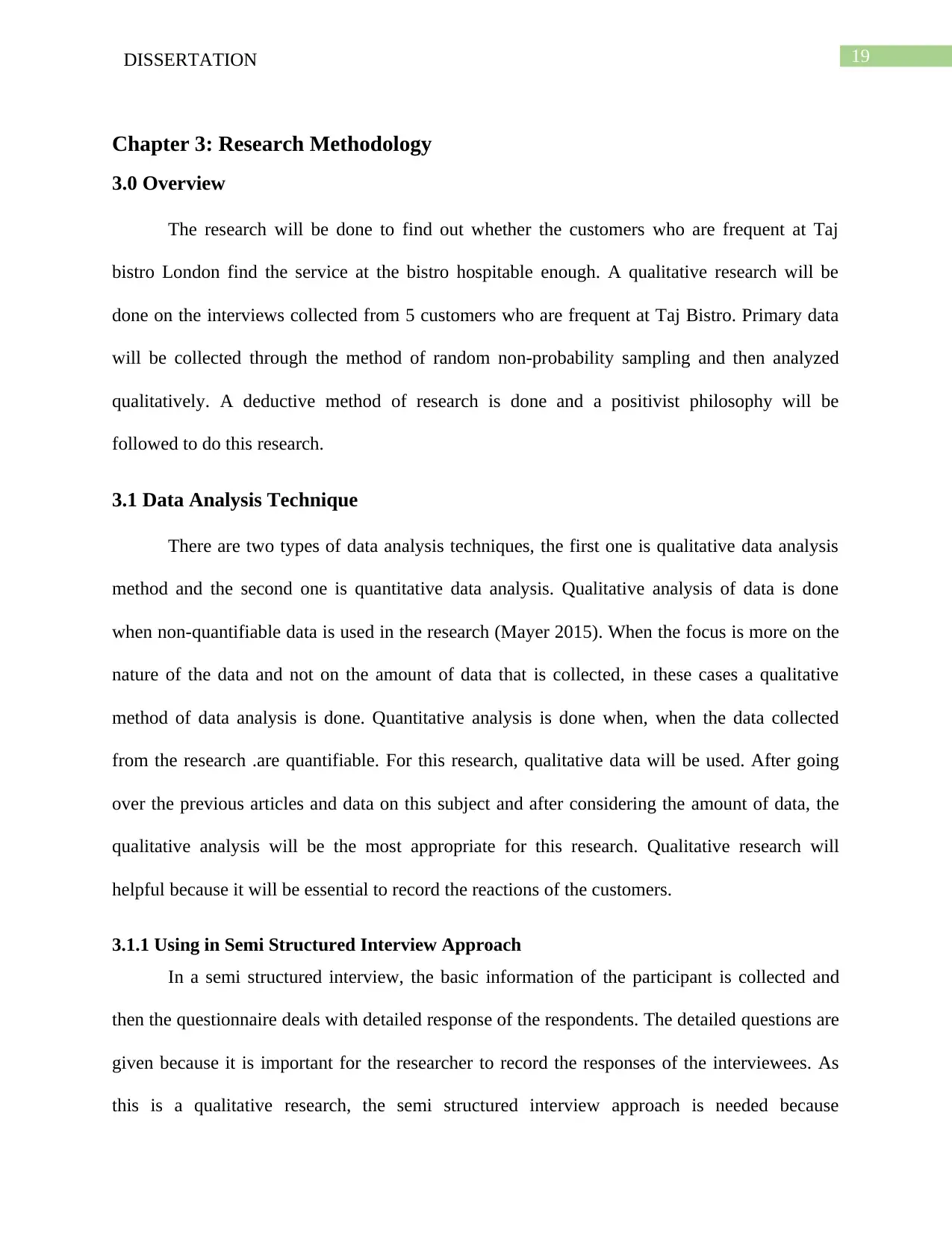
19DISSERTATION
Chapter 3: Research Methodology
3.0 Overview
The research will be done to find out whether the customers who are frequent at Taj
bistro London find the service at the bistro hospitable enough. A qualitative research will be
done on the interviews collected from 5 customers who are frequent at Taj Bistro. Primary data
will be collected through the method of random non-probability sampling and then analyzed
qualitatively. A deductive method of research is done and a positivist philosophy will be
followed to do this research.
3.1 Data Analysis Technique
There are two types of data analysis techniques, the first one is qualitative data analysis
method and the second one is quantitative data analysis. Qualitative analysis of data is done
when non-quantifiable data is used in the research (Mayer 2015). When the focus is more on the
nature of the data and not on the amount of data that is collected, in these cases a qualitative
method of data analysis is done. Quantitative analysis is done when, when the data collected
from the research .are quantifiable. For this research, qualitative data will be used. After going
over the previous articles and data on this subject and after considering the amount of data, the
qualitative analysis will be the most appropriate for this research. Qualitative research will
helpful because it will be essential to record the reactions of the customers.
3.1.1 Using in Semi Structured Interview Approach
In a semi structured interview, the basic information of the participant is collected and
then the questionnaire deals with detailed response of the respondents. The detailed questions are
given because it is important for the researcher to record the responses of the interviewees. As
this is a qualitative research, the semi structured interview approach is needed because
Chapter 3: Research Methodology
3.0 Overview
The research will be done to find out whether the customers who are frequent at Taj
bistro London find the service at the bistro hospitable enough. A qualitative research will be
done on the interviews collected from 5 customers who are frequent at Taj Bistro. Primary data
will be collected through the method of random non-probability sampling and then analyzed
qualitatively. A deductive method of research is done and a positivist philosophy will be
followed to do this research.
3.1 Data Analysis Technique
There are two types of data analysis techniques, the first one is qualitative data analysis
method and the second one is quantitative data analysis. Qualitative analysis of data is done
when non-quantifiable data is used in the research (Mayer 2015). When the focus is more on the
nature of the data and not on the amount of data that is collected, in these cases a qualitative
method of data analysis is done. Quantitative analysis is done when, when the data collected
from the research .are quantifiable. For this research, qualitative data will be used. After going
over the previous articles and data on this subject and after considering the amount of data, the
qualitative analysis will be the most appropriate for this research. Qualitative research will
helpful because it will be essential to record the reactions of the customers.
3.1.1 Using in Semi Structured Interview Approach
In a semi structured interview, the basic information of the participant is collected and
then the questionnaire deals with detailed response of the respondents. The detailed questions are
given because it is important for the researcher to record the responses of the interviewees. As
this is a qualitative research, the semi structured interview approach is needed because
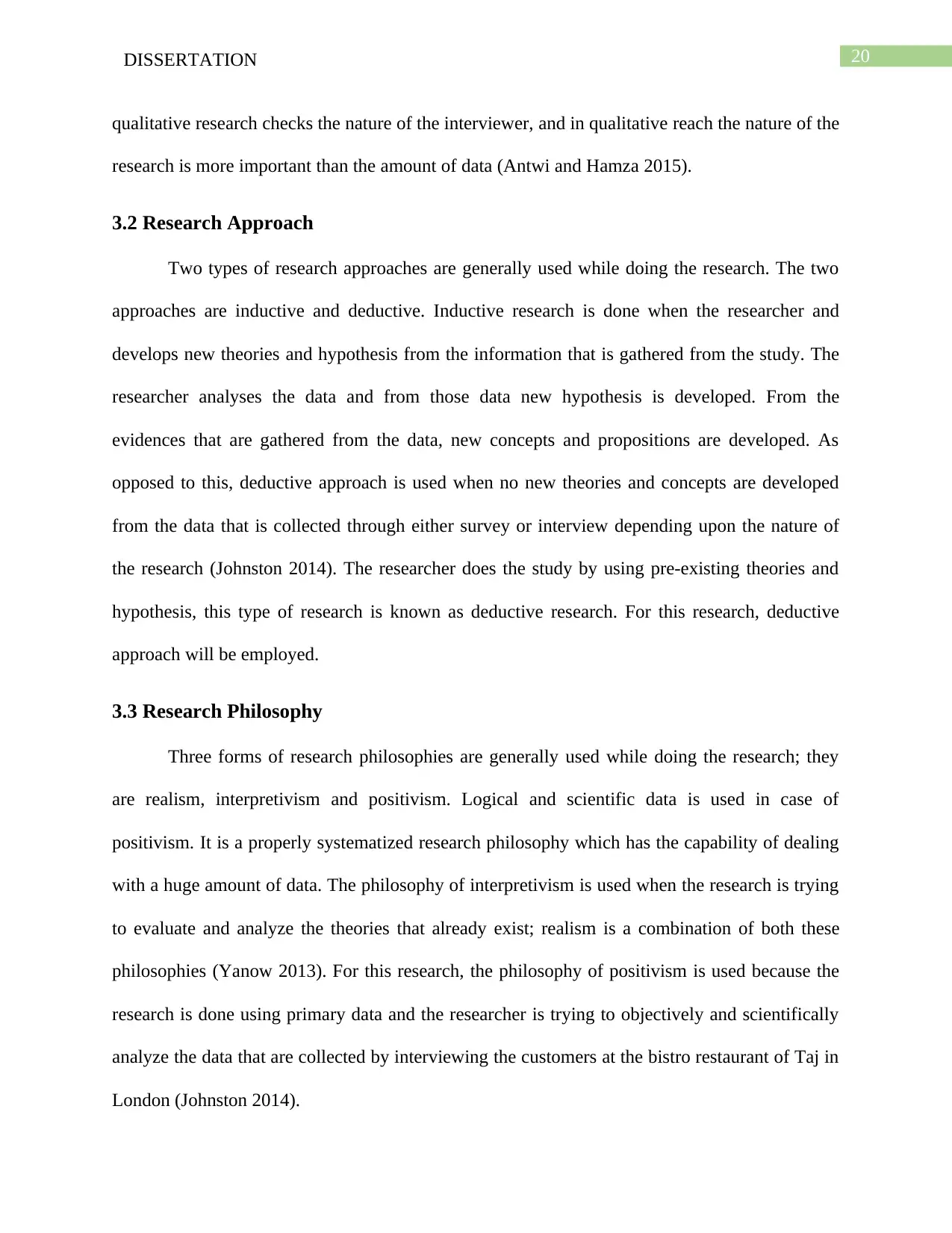
20DISSERTATION
qualitative research checks the nature of the interviewer, and in qualitative reach the nature of the
research is more important than the amount of data (Antwi and Hamza 2015).
3.2 Research Approach
Two types of research approaches are generally used while doing the research. The two
approaches are inductive and deductive. Inductive research is done when the researcher and
develops new theories and hypothesis from the information that is gathered from the study. The
researcher analyses the data and from those data new hypothesis is developed. From the
evidences that are gathered from the data, new concepts and propositions are developed. As
opposed to this, deductive approach is used when no new theories and concepts are developed
from the data that is collected through either survey or interview depending upon the nature of
the research (Johnston 2014). The researcher does the study by using pre-existing theories and
hypothesis, this type of research is known as deductive research. For this research, deductive
approach will be employed.
3.3 Research Philosophy
Three forms of research philosophies are generally used while doing the research; they
are realism, interpretivism and positivism. Logical and scientific data is used in case of
positivism. It is a properly systematized research philosophy which has the capability of dealing
with a huge amount of data. The philosophy of interpretivism is used when the research is trying
to evaluate and analyze the theories that already exist; realism is a combination of both these
philosophies (Yanow 2013). For this research, the philosophy of positivism is used because the
research is done using primary data and the researcher is trying to objectively and scientifically
analyze the data that are collected by interviewing the customers at the bistro restaurant of Taj in
London (Johnston 2014).
qualitative research checks the nature of the interviewer, and in qualitative reach the nature of the
research is more important than the amount of data (Antwi and Hamza 2015).
3.2 Research Approach
Two types of research approaches are generally used while doing the research. The two
approaches are inductive and deductive. Inductive research is done when the researcher and
develops new theories and hypothesis from the information that is gathered from the study. The
researcher analyses the data and from those data new hypothesis is developed. From the
evidences that are gathered from the data, new concepts and propositions are developed. As
opposed to this, deductive approach is used when no new theories and concepts are developed
from the data that is collected through either survey or interview depending upon the nature of
the research (Johnston 2014). The researcher does the study by using pre-existing theories and
hypothesis, this type of research is known as deductive research. For this research, deductive
approach will be employed.
3.3 Research Philosophy
Three forms of research philosophies are generally used while doing the research; they
are realism, interpretivism and positivism. Logical and scientific data is used in case of
positivism. It is a properly systematized research philosophy which has the capability of dealing
with a huge amount of data. The philosophy of interpretivism is used when the research is trying
to evaluate and analyze the theories that already exist; realism is a combination of both these
philosophies (Yanow 2013). For this research, the philosophy of positivism is used because the
research is done using primary data and the researcher is trying to objectively and scientifically
analyze the data that are collected by interviewing the customers at the bistro restaurant of Taj in
London (Johnston 2014).
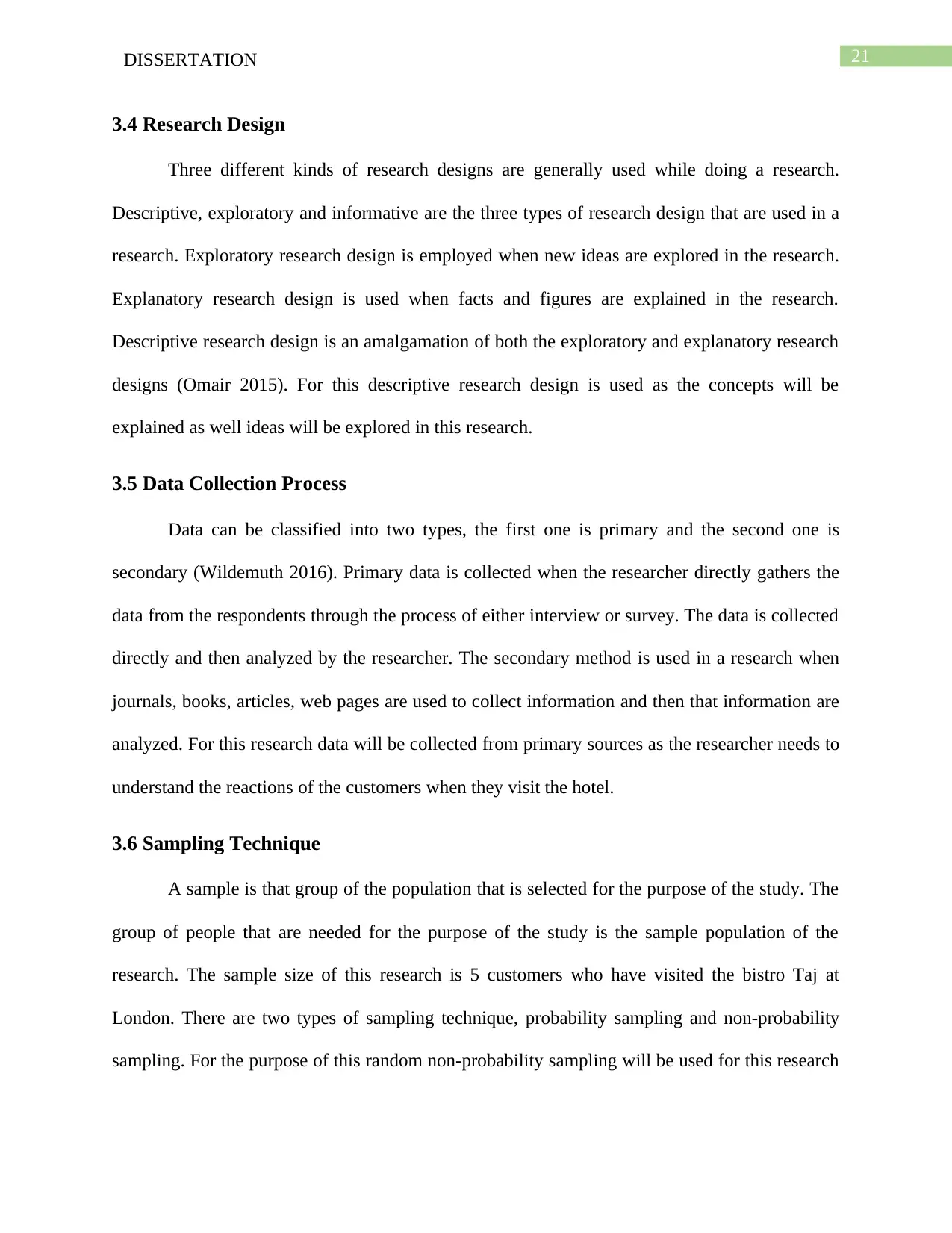
21DISSERTATION
3.4 Research Design
Three different kinds of research designs are generally used while doing a research.
Descriptive, exploratory and informative are the three types of research design that are used in a
research. Exploratory research design is employed when new ideas are explored in the research.
Explanatory research design is used when facts and figures are explained in the research.
Descriptive research design is an amalgamation of both the exploratory and explanatory research
designs (Omair 2015). For this descriptive research design is used as the concepts will be
explained as well ideas will be explored in this research.
3.5 Data Collection Process
Data can be classified into two types, the first one is primary and the second one is
secondary (Wildemuth 2016). Primary data is collected when the researcher directly gathers the
data from the respondents through the process of either interview or survey. The data is collected
directly and then analyzed by the researcher. The secondary method is used in a research when
journals, books, articles, web pages are used to collect information and then that information are
analyzed. For this research data will be collected from primary sources as the researcher needs to
understand the reactions of the customers when they visit the hotel.
3.6 Sampling Technique
A sample is that group of the population that is selected for the purpose of the study. The
group of people that are needed for the purpose of the study is the sample population of the
research. The sample size of this research is 5 customers who have visited the bistro Taj at
London. There are two types of sampling technique, probability sampling and non-probability
sampling. For the purpose of this random non-probability sampling will be used for this research
3.4 Research Design
Three different kinds of research designs are generally used while doing a research.
Descriptive, exploratory and informative are the three types of research design that are used in a
research. Exploratory research design is employed when new ideas are explored in the research.
Explanatory research design is used when facts and figures are explained in the research.
Descriptive research design is an amalgamation of both the exploratory and explanatory research
designs (Omair 2015). For this descriptive research design is used as the concepts will be
explained as well ideas will be explored in this research.
3.5 Data Collection Process
Data can be classified into two types, the first one is primary and the second one is
secondary (Wildemuth 2016). Primary data is collected when the researcher directly gathers the
data from the respondents through the process of either interview or survey. The data is collected
directly and then analyzed by the researcher. The secondary method is used in a research when
journals, books, articles, web pages are used to collect information and then that information are
analyzed. For this research data will be collected from primary sources as the researcher needs to
understand the reactions of the customers when they visit the hotel.
3.6 Sampling Technique
A sample is that group of the population that is selected for the purpose of the study. The
group of people that are needed for the purpose of the study is the sample population of the
research. The sample size of this research is 5 customers who have visited the bistro Taj at
London. There are two types of sampling technique, probability sampling and non-probability
sampling. For the purpose of this random non-probability sampling will be used for this research
Secure Best Marks with AI Grader
Need help grading? Try our AI Grader for instant feedback on your assignments.

22DISSERTATION
(Palinkas et al. 2015). This method is used because the researcher has selected the population
that is needed for the research.
3.7 Validity and Reliability in Research
Reliability is the measure of the constancy of test scores. It is the ability of the test to be
repeatable. For example a reliable math exam is intended to measure the mathematical
knowledge of every student. Reliability of a research is to make sure that there is universality in
the result of the research. The test that can be done for this research is called the Cronbach’s
alpha; this measures the inner dependability of the test with numerous answers (Bonett, D.G. and
Wright 2015).
3.8 Ethical Considerations
In case of this research, the ethical considerations that are to be taken are, no respondent
should be coerced into participating in the study. The data should not be manipulated and the
researcher should make sure that anonymity of the participant is kept if they have asked so. The
research should only be used for academic purpose and not for any other purposes.
3.7 Summary
The research will be done to check whether the bistro at Taj London is hospitable to their guest.
For doing this research 5 people are selected, who will be interviewed by the researcher and their
reactions will be further analyzed by the researcher to understand whether they feel that the
hospitality at Taj is good enough or there are things that needs to improve at that place.
(Palinkas et al. 2015). This method is used because the researcher has selected the population
that is needed for the research.
3.7 Validity and Reliability in Research
Reliability is the measure of the constancy of test scores. It is the ability of the test to be
repeatable. For example a reliable math exam is intended to measure the mathematical
knowledge of every student. Reliability of a research is to make sure that there is universality in
the result of the research. The test that can be done for this research is called the Cronbach’s
alpha; this measures the inner dependability of the test with numerous answers (Bonett, D.G. and
Wright 2015).
3.8 Ethical Considerations
In case of this research, the ethical considerations that are to be taken are, no respondent
should be coerced into participating in the study. The data should not be manipulated and the
researcher should make sure that anonymity of the participant is kept if they have asked so. The
research should only be used for academic purpose and not for any other purposes.
3.7 Summary
The research will be done to check whether the bistro at Taj London is hospitable to their guest.
For doing this research 5 people are selected, who will be interviewed by the researcher and their
reactions will be further analyzed by the researcher to understand whether they feel that the
hospitality at Taj is good enough or there are things that needs to improve at that place.

23DISSERTATION
Chapter 4: Data Analysis
4.0 Over view
This chapter analyzes all the data that has been gathered in the course of the research
work under investigation. The main aim of the research is to understand the concepts of food
quality and service quality and analyze their importance on the factor of customer satisfaction
with regards to the hotel and hospitality industry, by placing special attention to the Bistro
restaurant of Taj in London. In this regard, various sources of literature has been examined and
discussed. Moreover, several frequent customers have been interviewed who frequent the Taj
restaurant in London. Their opinions have been analyzed in this chapter.
4.1 Data Findings
The section on literature review tries to show the various sources of literature such as
books, academic journals and articles in order to understand the main and purpose of the
research. Furthermore, in order to gain a firsthand information about how the factors of food
quality and service quality affects the element of customer satisfaction, several customers have
been interviewed. In this regard, five customers who frequent the Bistro restaurant of Taj in
London, the United Kingdom have been interviewed. The information gathered from the
customers provide their personal opinions with regard to the independent variables such as the
quality of the food and the service quality of the study and their impact on the dependable
variable which is customer satisfaction (Hanaysha 2016).
The customers were asked the question that if they are happy with the food that was
being provided by the restaurant of Taj in London. To this, three customers agreed that they were
indeed satisfied with the food provided. However, one of the other customer was of the idea that
Chapter 4: Data Analysis
4.0 Over view
This chapter analyzes all the data that has been gathered in the course of the research
work under investigation. The main aim of the research is to understand the concepts of food
quality and service quality and analyze their importance on the factor of customer satisfaction
with regards to the hotel and hospitality industry, by placing special attention to the Bistro
restaurant of Taj in London. In this regard, various sources of literature has been examined and
discussed. Moreover, several frequent customers have been interviewed who frequent the Taj
restaurant in London. Their opinions have been analyzed in this chapter.
4.1 Data Findings
The section on literature review tries to show the various sources of literature such as
books, academic journals and articles in order to understand the main and purpose of the
research. Furthermore, in order to gain a firsthand information about how the factors of food
quality and service quality affects the element of customer satisfaction, several customers have
been interviewed. In this regard, five customers who frequent the Bistro restaurant of Taj in
London, the United Kingdom have been interviewed. The information gathered from the
customers provide their personal opinions with regard to the independent variables such as the
quality of the food and the service quality of the study and their impact on the dependable
variable which is customer satisfaction (Hanaysha 2016).
The customers were asked the question that if they are happy with the food that was
being provided by the restaurant of Taj in London. To this, three customers agreed that they were
indeed satisfied with the food provided. However, one of the other customer was of the idea that
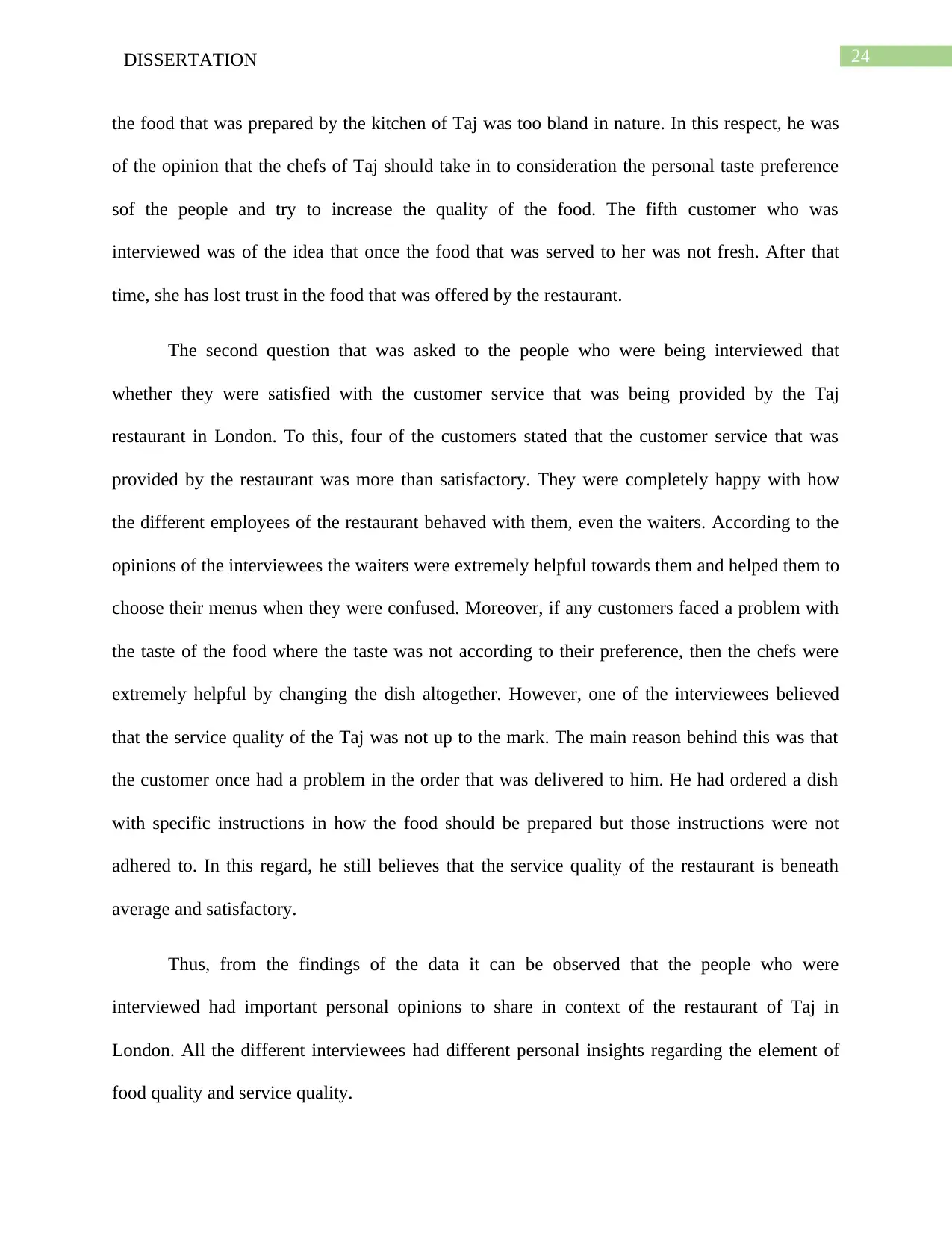
24DISSERTATION
the food that was prepared by the kitchen of Taj was too bland in nature. In this respect, he was
of the opinion that the chefs of Taj should take in to consideration the personal taste preference
sof the people and try to increase the quality of the food. The fifth customer who was
interviewed was of the idea that once the food that was served to her was not fresh. After that
time, she has lost trust in the food that was offered by the restaurant.
The second question that was asked to the people who were being interviewed that
whether they were satisfied with the customer service that was being provided by the Taj
restaurant in London. To this, four of the customers stated that the customer service that was
provided by the restaurant was more than satisfactory. They were completely happy with how
the different employees of the restaurant behaved with them, even the waiters. According to the
opinions of the interviewees the waiters were extremely helpful towards them and helped them to
choose their menus when they were confused. Moreover, if any customers faced a problem with
the taste of the food where the taste was not according to their preference, then the chefs were
extremely helpful by changing the dish altogether. However, one of the interviewees believed
that the service quality of the Taj was not up to the mark. The main reason behind this was that
the customer once had a problem in the order that was delivered to him. He had ordered a dish
with specific instructions in how the food should be prepared but those instructions were not
adhered to. In this regard, he still believes that the service quality of the restaurant is beneath
average and satisfactory.
Thus, from the findings of the data it can be observed that the people who were
interviewed had important personal opinions to share in context of the restaurant of Taj in
London. All the different interviewees had different personal insights regarding the element of
food quality and service quality.
the food that was prepared by the kitchen of Taj was too bland in nature. In this respect, he was
of the opinion that the chefs of Taj should take in to consideration the personal taste preference
sof the people and try to increase the quality of the food. The fifth customer who was
interviewed was of the idea that once the food that was served to her was not fresh. After that
time, she has lost trust in the food that was offered by the restaurant.
The second question that was asked to the people who were being interviewed that
whether they were satisfied with the customer service that was being provided by the Taj
restaurant in London. To this, four of the customers stated that the customer service that was
provided by the restaurant was more than satisfactory. They were completely happy with how
the different employees of the restaurant behaved with them, even the waiters. According to the
opinions of the interviewees the waiters were extremely helpful towards them and helped them to
choose their menus when they were confused. Moreover, if any customers faced a problem with
the taste of the food where the taste was not according to their preference, then the chefs were
extremely helpful by changing the dish altogether. However, one of the interviewees believed
that the service quality of the Taj was not up to the mark. The main reason behind this was that
the customer once had a problem in the order that was delivered to him. He had ordered a dish
with specific instructions in how the food should be prepared but those instructions were not
adhered to. In this regard, he still believes that the service quality of the restaurant is beneath
average and satisfactory.
Thus, from the findings of the data it can be observed that the people who were
interviewed had important personal opinions to share in context of the restaurant of Taj in
London. All the different interviewees had different personal insights regarding the element of
food quality and service quality.
Paraphrase This Document
Need a fresh take? Get an instant paraphrase of this document with our AI Paraphraser
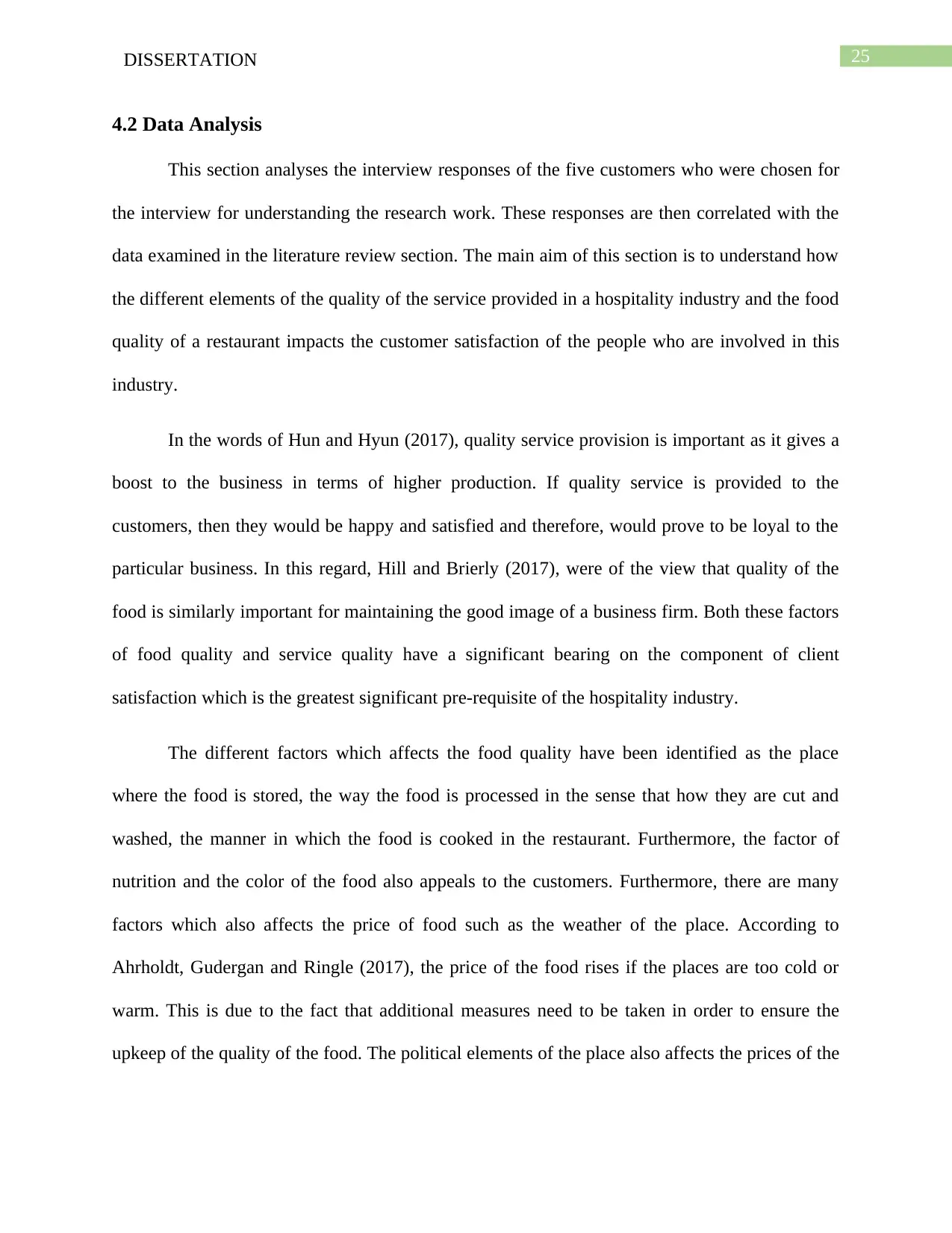
25DISSERTATION
4.2 Data Analysis
This section analyses the interview responses of the five customers who were chosen for
the interview for understanding the research work. These responses are then correlated with the
data examined in the literature review section. The main aim of this section is to understand how
the different elements of the quality of the service provided in a hospitality industry and the food
quality of a restaurant impacts the customer satisfaction of the people who are involved in this
industry.
In the words of Hun and Hyun (2017), quality service provision is important as it gives a
boost to the business in terms of higher production. If quality service is provided to the
customers, then they would be happy and satisfied and therefore, would prove to be loyal to the
particular business. In this regard, Hill and Brierly (2017), were of the view that quality of the
food is similarly important for maintaining the good image of a business firm. Both these factors
of food quality and service quality have a significant bearing on the component of client
satisfaction which is the greatest significant pre-requisite of the hospitality industry.
The different factors which affects the food quality have been identified as the place
where the food is stored, the way the food is processed in the sense that how they are cut and
washed, the manner in which the food is cooked in the restaurant. Furthermore, the factor of
nutrition and the color of the food also appeals to the customers. Furthermore, there are many
factors which also affects the price of food such as the weather of the place. According to
Ahrholdt, Gudergan and Ringle (2017), the price of the food rises if the places are too cold or
warm. This is due to the fact that additional measures need to be taken in order to ensure the
upkeep of the quality of the food. The political elements of the place also affects the prices of the
4.2 Data Analysis
This section analyses the interview responses of the five customers who were chosen for
the interview for understanding the research work. These responses are then correlated with the
data examined in the literature review section. The main aim of this section is to understand how
the different elements of the quality of the service provided in a hospitality industry and the food
quality of a restaurant impacts the customer satisfaction of the people who are involved in this
industry.
In the words of Hun and Hyun (2017), quality service provision is important as it gives a
boost to the business in terms of higher production. If quality service is provided to the
customers, then they would be happy and satisfied and therefore, would prove to be loyal to the
particular business. In this regard, Hill and Brierly (2017), were of the view that quality of the
food is similarly important for maintaining the good image of a business firm. Both these factors
of food quality and service quality have a significant bearing on the component of client
satisfaction which is the greatest significant pre-requisite of the hospitality industry.
The different factors which affects the food quality have been identified as the place
where the food is stored, the way the food is processed in the sense that how they are cut and
washed, the manner in which the food is cooked in the restaurant. Furthermore, the factor of
nutrition and the color of the food also appeals to the customers. Furthermore, there are many
factors which also affects the price of food such as the weather of the place. According to
Ahrholdt, Gudergan and Ringle (2017), the price of the food rises if the places are too cold or
warm. This is due to the fact that additional measures need to be taken in order to ensure the
upkeep of the quality of the food. The political elements of the place also affects the prices of the
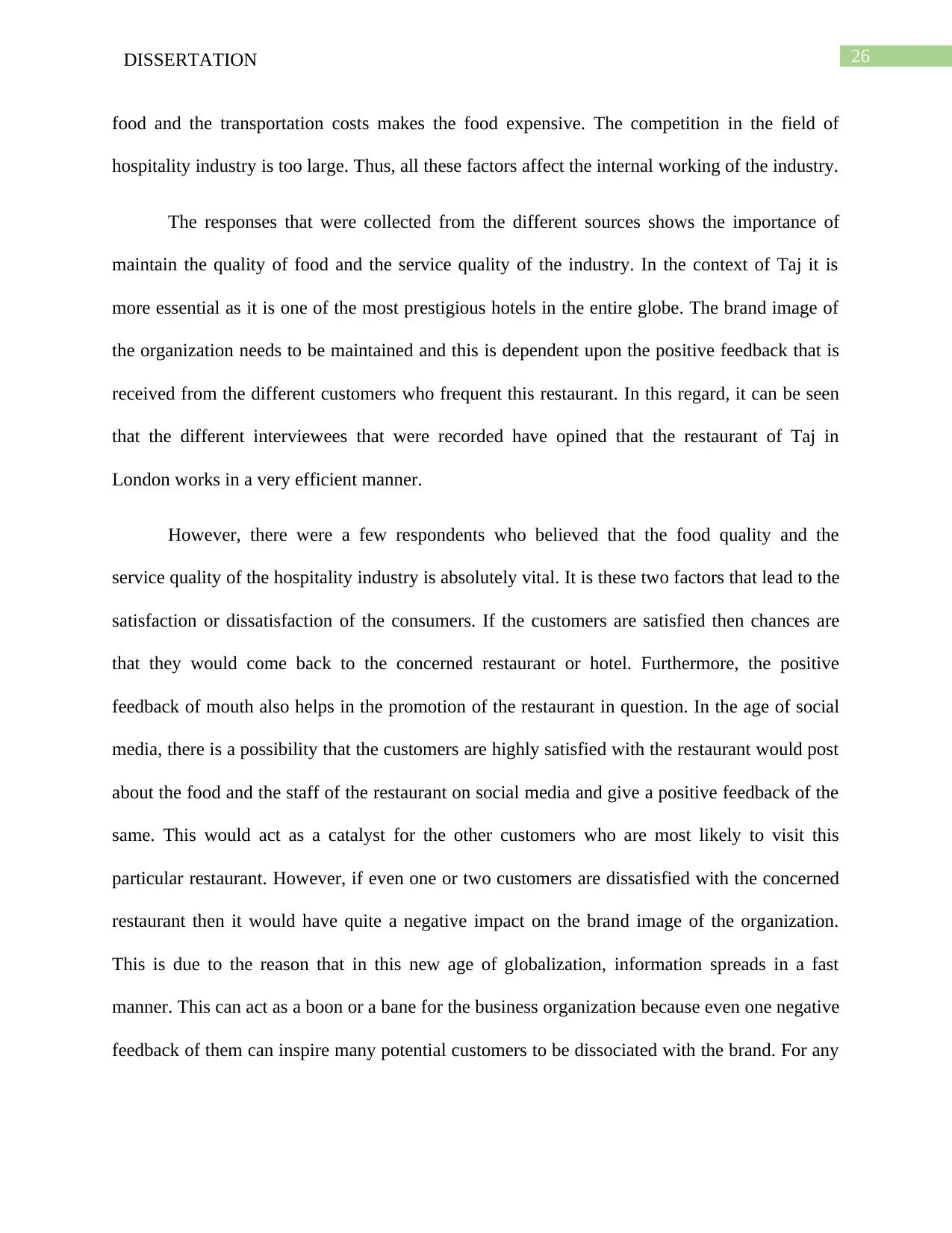
26DISSERTATION
food and the transportation costs makes the food expensive. The competition in the field of
hospitality industry is too large. Thus, all these factors affect the internal working of the industry.
The responses that were collected from the different sources shows the importance of
maintain the quality of food and the service quality of the industry. In the context of Taj it is
more essential as it is one of the most prestigious hotels in the entire globe. The brand image of
the organization needs to be maintained and this is dependent upon the positive feedback that is
received from the different customers who frequent this restaurant. In this regard, it can be seen
that the different interviewees that were recorded have opined that the restaurant of Taj in
London works in a very efficient manner.
However, there were a few respondents who believed that the food quality and the
service quality of the hospitality industry is absolutely vital. It is these two factors that lead to the
satisfaction or dissatisfaction of the consumers. If the customers are satisfied then chances are
that they would come back to the concerned restaurant or hotel. Furthermore, the positive
feedback of mouth also helps in the promotion of the restaurant in question. In the age of social
media, there is a possibility that the customers are highly satisfied with the restaurant would post
about the food and the staff of the restaurant on social media and give a positive feedback of the
same. This would act as a catalyst for the other customers who are most likely to visit this
particular restaurant. However, if even one or two customers are dissatisfied with the concerned
restaurant then it would have quite a negative impact on the brand image of the organization.
This is due to the reason that in this new age of globalization, information spreads in a fast
manner. This can act as a boon or a bane for the business organization because even one negative
feedback of them can inspire many potential customers to be dissociated with the brand. For any
food and the transportation costs makes the food expensive. The competition in the field of
hospitality industry is too large. Thus, all these factors affect the internal working of the industry.
The responses that were collected from the different sources shows the importance of
maintain the quality of food and the service quality of the industry. In the context of Taj it is
more essential as it is one of the most prestigious hotels in the entire globe. The brand image of
the organization needs to be maintained and this is dependent upon the positive feedback that is
received from the different customers who frequent this restaurant. In this regard, it can be seen
that the different interviewees that were recorded have opined that the restaurant of Taj in
London works in a very efficient manner.
However, there were a few respondents who believed that the food quality and the
service quality of the hospitality industry is absolutely vital. It is these two factors that lead to the
satisfaction or dissatisfaction of the consumers. If the customers are satisfied then chances are
that they would come back to the concerned restaurant or hotel. Furthermore, the positive
feedback of mouth also helps in the promotion of the restaurant in question. In the age of social
media, there is a possibility that the customers are highly satisfied with the restaurant would post
about the food and the staff of the restaurant on social media and give a positive feedback of the
same. This would act as a catalyst for the other customers who are most likely to visit this
particular restaurant. However, if even one or two customers are dissatisfied with the concerned
restaurant then it would have quite a negative impact on the brand image of the organization.
This is due to the reason that in this new age of globalization, information spreads in a fast
manner. This can act as a boon or a bane for the business organization because even one negative
feedback of them can inspire many potential customers to be dissociated with the brand. For any
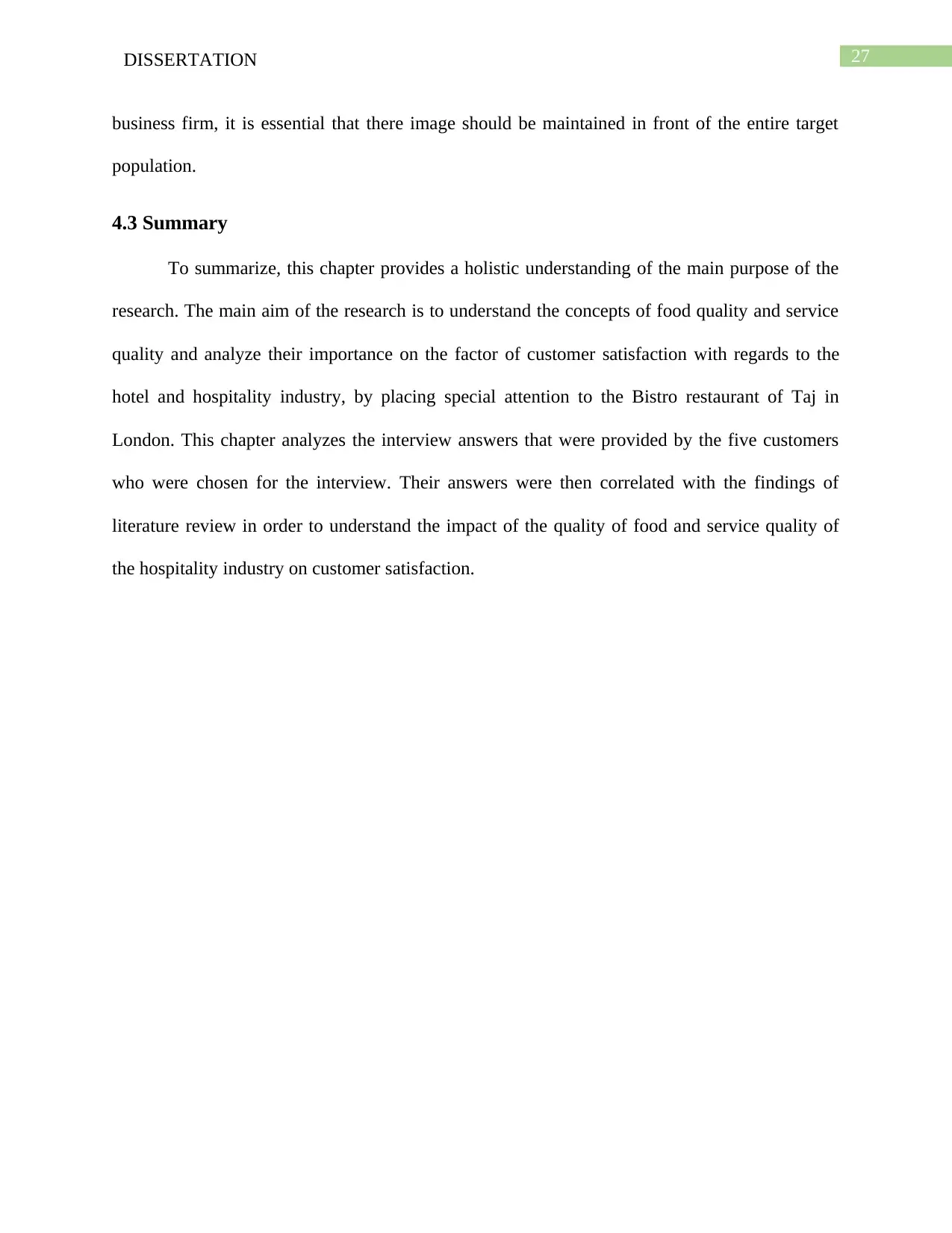
27DISSERTATION
business firm, it is essential that there image should be maintained in front of the entire target
population.
4.3 Summary
To summarize, this chapter provides a holistic understanding of the main purpose of the
research. The main aim of the research is to understand the concepts of food quality and service
quality and analyze their importance on the factor of customer satisfaction with regards to the
hotel and hospitality industry, by placing special attention to the Bistro restaurant of Taj in
London. This chapter analyzes the interview answers that were provided by the five customers
who were chosen for the interview. Their answers were then correlated with the findings of
literature review in order to understand the impact of the quality of food and service quality of
the hospitality industry on customer satisfaction.
business firm, it is essential that there image should be maintained in front of the entire target
population.
4.3 Summary
To summarize, this chapter provides a holistic understanding of the main purpose of the
research. The main aim of the research is to understand the concepts of food quality and service
quality and analyze their importance on the factor of customer satisfaction with regards to the
hotel and hospitality industry, by placing special attention to the Bistro restaurant of Taj in
London. This chapter analyzes the interview answers that were provided by the five customers
who were chosen for the interview. Their answers were then correlated with the findings of
literature review in order to understand the impact of the quality of food and service quality of
the hospitality industry on customer satisfaction.
Secure Best Marks with AI Grader
Need help grading? Try our AI Grader for instant feedback on your assignments.
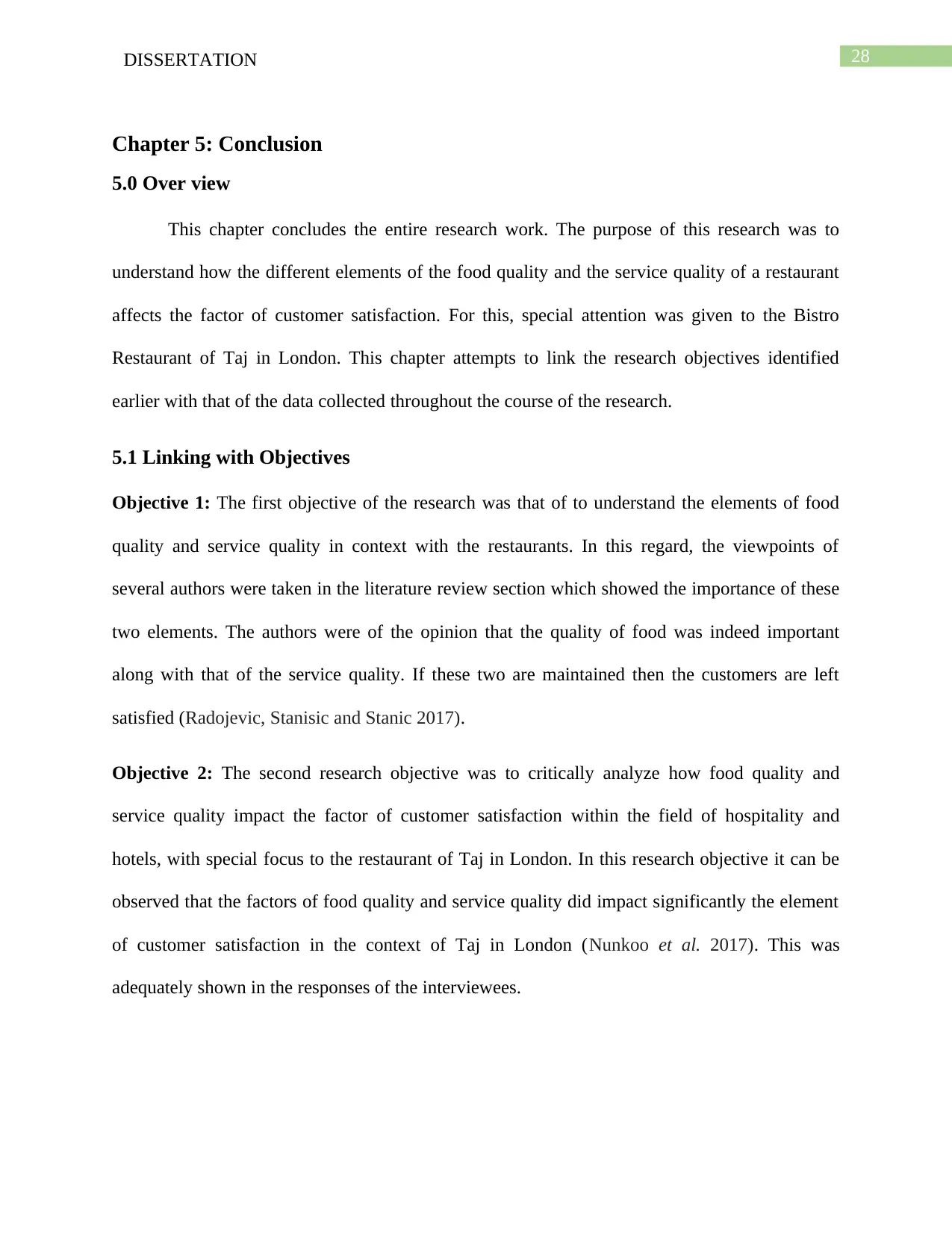
28DISSERTATION
Chapter 5: Conclusion
5.0 Over view
This chapter concludes the entire research work. The purpose of this research was to
understand how the different elements of the food quality and the service quality of a restaurant
affects the factor of customer satisfaction. For this, special attention was given to the Bistro
Restaurant of Taj in London. This chapter attempts to link the research objectives identified
earlier with that of the data collected throughout the course of the research.
5.1 Linking with Objectives
Objective 1: The first objective of the research was that of to understand the elements of food
quality and service quality in context with the restaurants. In this regard, the viewpoints of
several authors were taken in the literature review section which showed the importance of these
two elements. The authors were of the opinion that the quality of food was indeed important
along with that of the service quality. If these two are maintained then the customers are left
satisfied (Radojevic, Stanisic and Stanic 2017).
Objective 2: The second research objective was to critically analyze how food quality and
service quality impact the factor of customer satisfaction within the field of hospitality and
hotels, with special focus to the restaurant of Taj in London. In this research objective it can be
observed that the factors of food quality and service quality did impact significantly the element
of customer satisfaction in the context of Taj in London (Nunkoo et al. 2017). This was
adequately shown in the responses of the interviewees.
Chapter 5: Conclusion
5.0 Over view
This chapter concludes the entire research work. The purpose of this research was to
understand how the different elements of the food quality and the service quality of a restaurant
affects the factor of customer satisfaction. For this, special attention was given to the Bistro
Restaurant of Taj in London. This chapter attempts to link the research objectives identified
earlier with that of the data collected throughout the course of the research.
5.1 Linking with Objectives
Objective 1: The first objective of the research was that of to understand the elements of food
quality and service quality in context with the restaurants. In this regard, the viewpoints of
several authors were taken in the literature review section which showed the importance of these
two elements. The authors were of the opinion that the quality of food was indeed important
along with that of the service quality. If these two are maintained then the customers are left
satisfied (Radojevic, Stanisic and Stanic 2017).
Objective 2: The second research objective was to critically analyze how food quality and
service quality impact the factor of customer satisfaction within the field of hospitality and
hotels, with special focus to the restaurant of Taj in London. In this research objective it can be
observed that the factors of food quality and service quality did impact significantly the element
of customer satisfaction in the context of Taj in London (Nunkoo et al. 2017). This was
adequately shown in the responses of the interviewees.
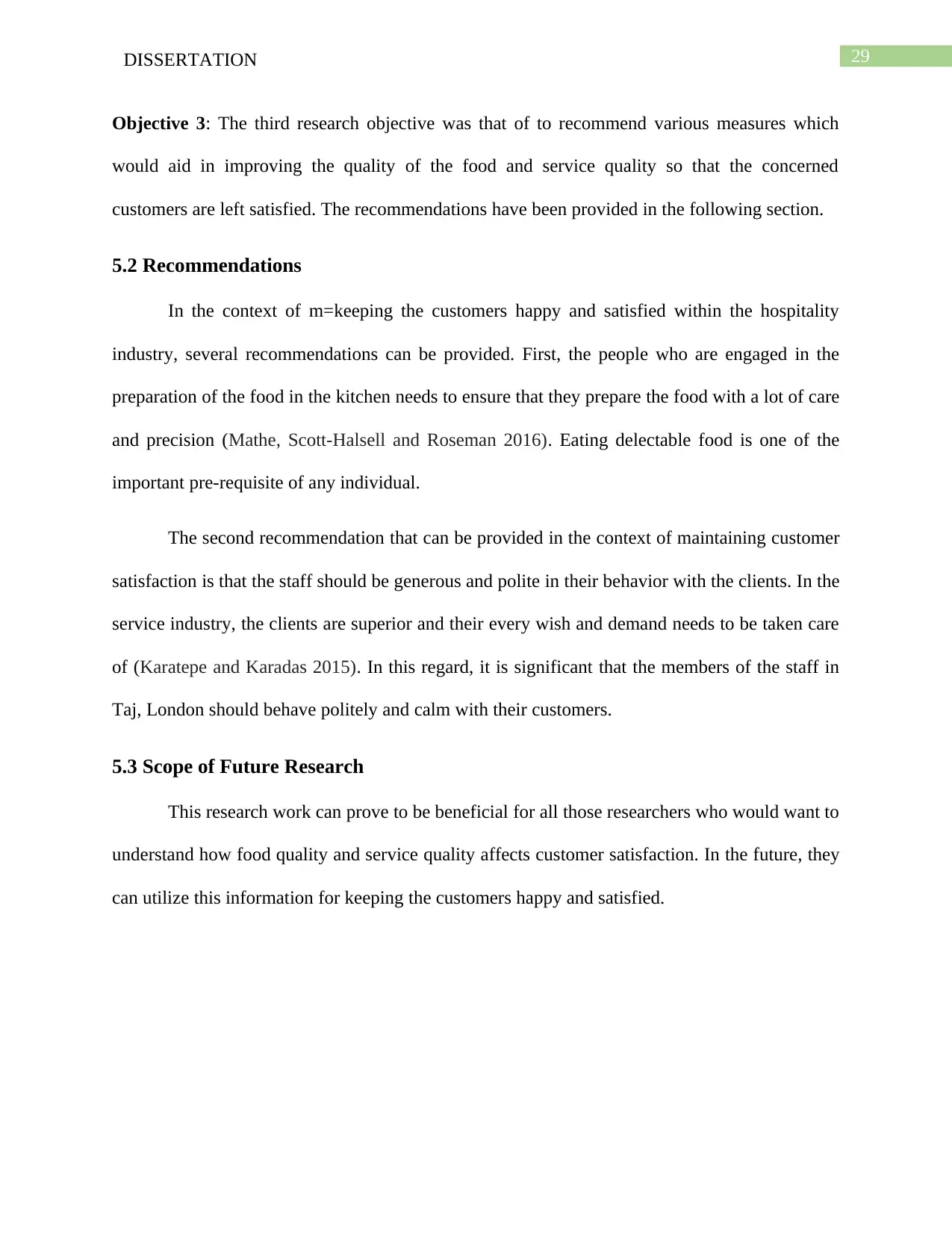
29DISSERTATION
Objective 3: The third research objective was that of to recommend various measures which
would aid in improving the quality of the food and service quality so that the concerned
customers are left satisfied. The recommendations have been provided in the following section.
5.2 Recommendations
In the context of m=keeping the customers happy and satisfied within the hospitality
industry, several recommendations can be provided. First, the people who are engaged in the
preparation of the food in the kitchen needs to ensure that they prepare the food with a lot of care
and precision (Mathe, Scott-Halsell and Roseman 2016). Eating delectable food is one of the
important pre-requisite of any individual.
The second recommendation that can be provided in the context of maintaining customer
satisfaction is that the staff should be generous and polite in their behavior with the clients. In the
service industry, the clients are superior and their every wish and demand needs to be taken care
of (Karatepe and Karadas 2015). In this regard, it is significant that the members of the staff in
Taj, London should behave politely and calm with their customers.
5.3 Scope of Future Research
This research work can prove to be beneficial for all those researchers who would want to
understand how food quality and service quality affects customer satisfaction. In the future, they
can utilize this information for keeping the customers happy and satisfied.
Objective 3: The third research objective was that of to recommend various measures which
would aid in improving the quality of the food and service quality so that the concerned
customers are left satisfied. The recommendations have been provided in the following section.
5.2 Recommendations
In the context of m=keeping the customers happy and satisfied within the hospitality
industry, several recommendations can be provided. First, the people who are engaged in the
preparation of the food in the kitchen needs to ensure that they prepare the food with a lot of care
and precision (Mathe, Scott-Halsell and Roseman 2016). Eating delectable food is one of the
important pre-requisite of any individual.
The second recommendation that can be provided in the context of maintaining customer
satisfaction is that the staff should be generous and polite in their behavior with the clients. In the
service industry, the clients are superior and their every wish and demand needs to be taken care
of (Karatepe and Karadas 2015). In this regard, it is significant that the members of the staff in
Taj, London should behave politely and calm with their customers.
5.3 Scope of Future Research
This research work can prove to be beneficial for all those researchers who would want to
understand how food quality and service quality affects customer satisfaction. In the future, they
can utilize this information for keeping the customers happy and satisfied.
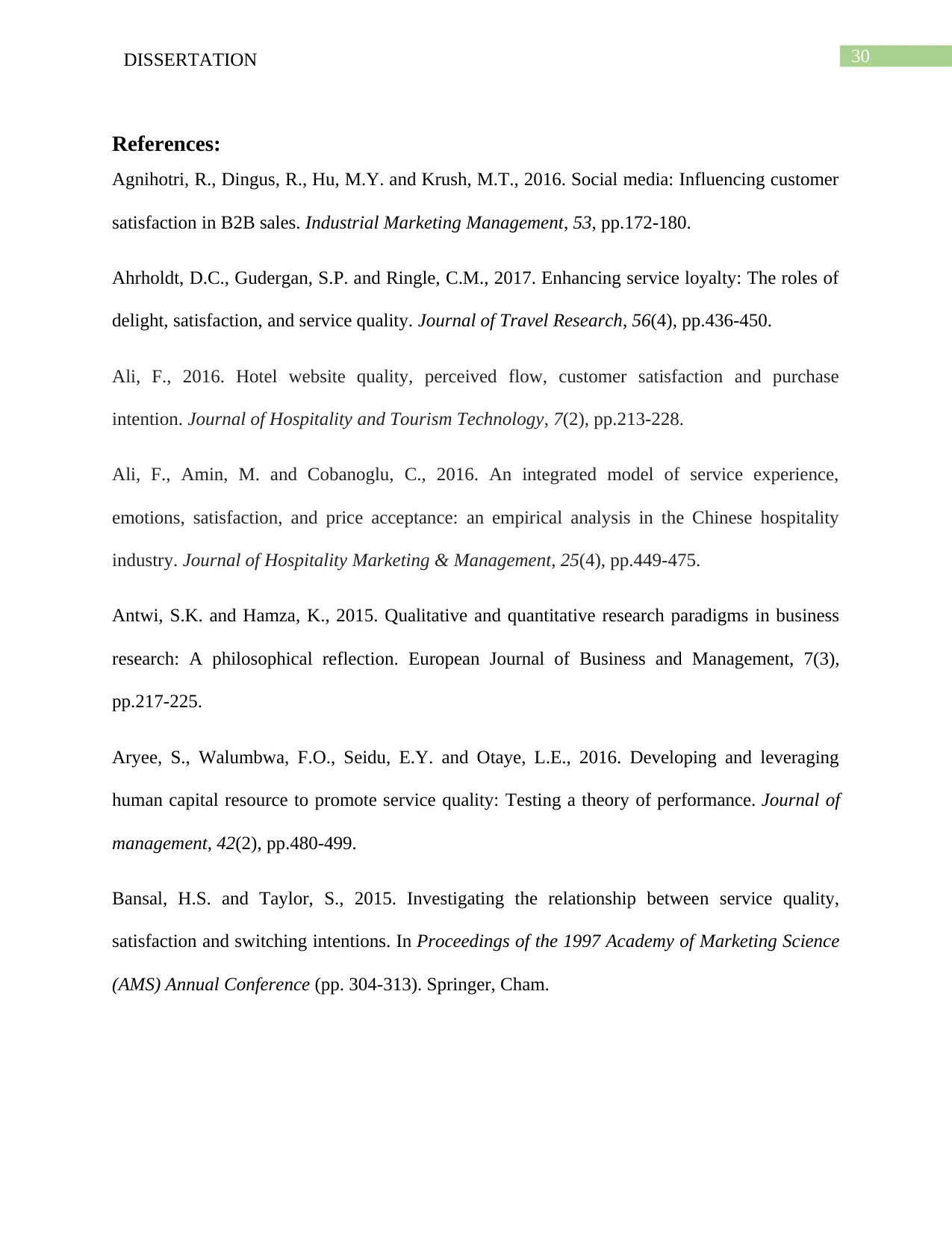
30DISSERTATION
References:
Agnihotri, R., Dingus, R., Hu, M.Y. and Krush, M.T., 2016. Social media: Influencing customer
satisfaction in B2B sales. Industrial Marketing Management, 53, pp.172-180.
Ahrholdt, D.C., Gudergan, S.P. and Ringle, C.M., 2017. Enhancing service loyalty: The roles of
delight, satisfaction, and service quality. Journal of Travel Research, 56(4), pp.436-450.
Ali, F., 2016. Hotel website quality, perceived flow, customer satisfaction and purchase
intention. Journal of Hospitality and Tourism Technology, 7(2), pp.213-228.
Ali, F., Amin, M. and Cobanoglu, C., 2016. An integrated model of service experience,
emotions, satisfaction, and price acceptance: an empirical analysis in the Chinese hospitality
industry. Journal of Hospitality Marketing & Management, 25(4), pp.449-475.
Antwi, S.K. and Hamza, K., 2015. Qualitative and quantitative research paradigms in business
research: A philosophical reflection. European Journal of Business and Management, 7(3),
pp.217-225.
Aryee, S., Walumbwa, F.O., Seidu, E.Y. and Otaye, L.E., 2016. Developing and leveraging
human capital resource to promote service quality: Testing a theory of performance. Journal of
management, 42(2), pp.480-499.
Bansal, H.S. and Taylor, S., 2015. Investigating the relationship between service quality,
satisfaction and switching intentions. In Proceedings of the 1997 Academy of Marketing Science
(AMS) Annual Conference (pp. 304-313). Springer, Cham.
References:
Agnihotri, R., Dingus, R., Hu, M.Y. and Krush, M.T., 2016. Social media: Influencing customer
satisfaction in B2B sales. Industrial Marketing Management, 53, pp.172-180.
Ahrholdt, D.C., Gudergan, S.P. and Ringle, C.M., 2017. Enhancing service loyalty: The roles of
delight, satisfaction, and service quality. Journal of Travel Research, 56(4), pp.436-450.
Ali, F., 2016. Hotel website quality, perceived flow, customer satisfaction and purchase
intention. Journal of Hospitality and Tourism Technology, 7(2), pp.213-228.
Ali, F., Amin, M. and Cobanoglu, C., 2016. An integrated model of service experience,
emotions, satisfaction, and price acceptance: an empirical analysis in the Chinese hospitality
industry. Journal of Hospitality Marketing & Management, 25(4), pp.449-475.
Antwi, S.K. and Hamza, K., 2015. Qualitative and quantitative research paradigms in business
research: A philosophical reflection. European Journal of Business and Management, 7(3),
pp.217-225.
Aryee, S., Walumbwa, F.O., Seidu, E.Y. and Otaye, L.E., 2016. Developing and leveraging
human capital resource to promote service quality: Testing a theory of performance. Journal of
management, 42(2), pp.480-499.
Bansal, H.S. and Taylor, S., 2015. Investigating the relationship between service quality,
satisfaction and switching intentions. In Proceedings of the 1997 Academy of Marketing Science
(AMS) Annual Conference (pp. 304-313). Springer, Cham.
Paraphrase This Document
Need a fresh take? Get an instant paraphrase of this document with our AI Paraphraser
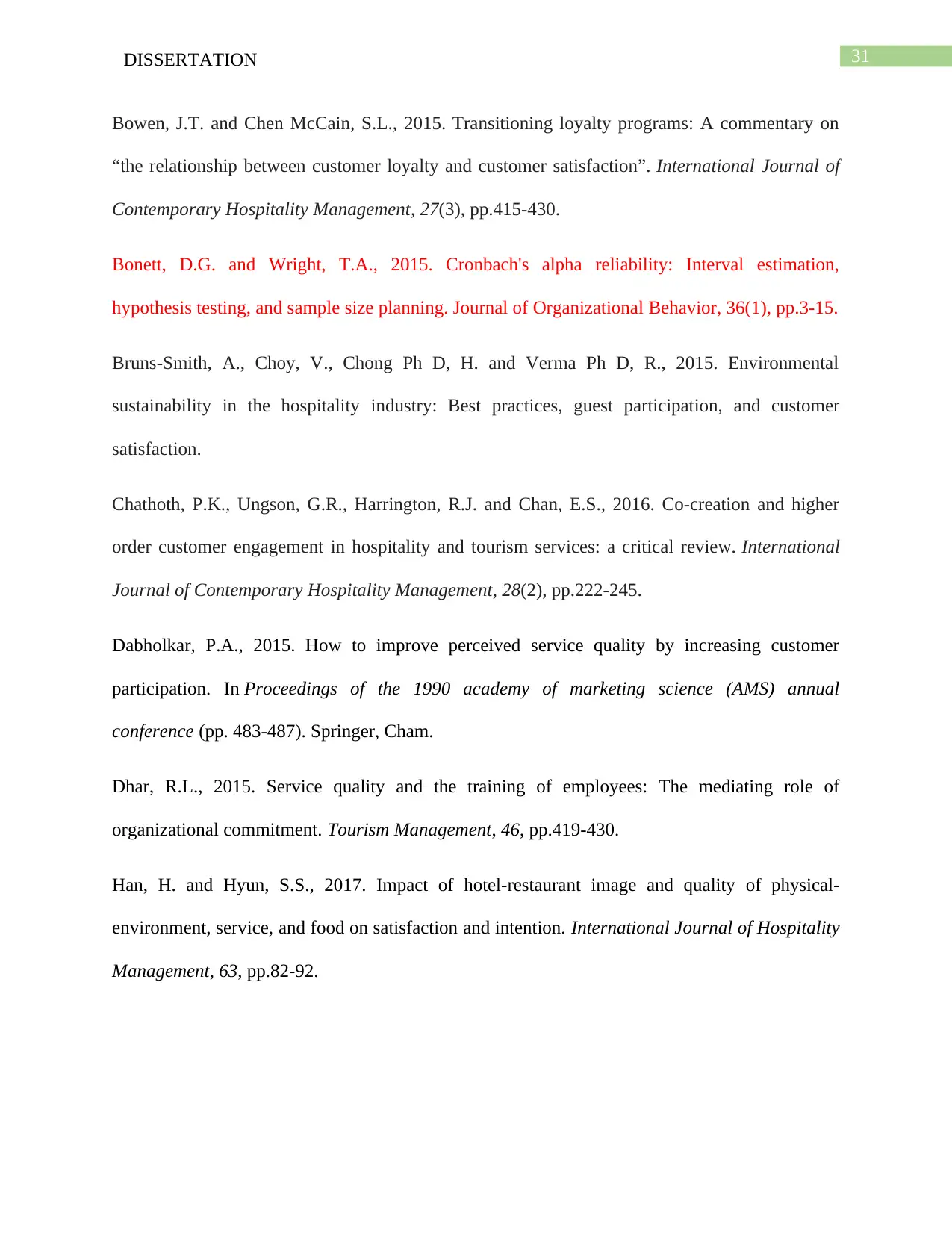
31DISSERTATION
Bowen, J.T. and Chen McCain, S.L., 2015. Transitioning loyalty programs: A commentary on
“the relationship between customer loyalty and customer satisfaction”. International Journal of
Contemporary Hospitality Management, 27(3), pp.415-430.
Bonett, D.G. and Wright, T.A., 2015. Cronbach's alpha reliability: Interval estimation,
hypothesis testing, and sample size planning. Journal of Organizational Behavior, 36(1), pp.3-15.
Bruns-Smith, A., Choy, V., Chong Ph D, H. and Verma Ph D, R., 2015. Environmental
sustainability in the hospitality industry: Best practices, guest participation, and customer
satisfaction.
Chathoth, P.K., Ungson, G.R., Harrington, R.J. and Chan, E.S., 2016. Co-creation and higher
order customer engagement in hospitality and tourism services: a critical review. International
Journal of Contemporary Hospitality Management, 28(2), pp.222-245.
Dabholkar, P.A., 2015. How to improve perceived service quality by increasing customer
participation. In Proceedings of the 1990 academy of marketing science (AMS) annual
conference (pp. 483-487). Springer, Cham.
Dhar, R.L., 2015. Service quality and the training of employees: The mediating role of
organizational commitment. Tourism Management, 46, pp.419-430.
Han, H. and Hyun, S.S., 2017. Impact of hotel-restaurant image and quality of physical-
environment, service, and food on satisfaction and intention. International Journal of Hospitality
Management, 63, pp.82-92.
Bowen, J.T. and Chen McCain, S.L., 2015. Transitioning loyalty programs: A commentary on
“the relationship between customer loyalty and customer satisfaction”. International Journal of
Contemporary Hospitality Management, 27(3), pp.415-430.
Bonett, D.G. and Wright, T.A., 2015. Cronbach's alpha reliability: Interval estimation,
hypothesis testing, and sample size planning. Journal of Organizational Behavior, 36(1), pp.3-15.
Bruns-Smith, A., Choy, V., Chong Ph D, H. and Verma Ph D, R., 2015. Environmental
sustainability in the hospitality industry: Best practices, guest participation, and customer
satisfaction.
Chathoth, P.K., Ungson, G.R., Harrington, R.J. and Chan, E.S., 2016. Co-creation and higher
order customer engagement in hospitality and tourism services: a critical review. International
Journal of Contemporary Hospitality Management, 28(2), pp.222-245.
Dabholkar, P.A., 2015. How to improve perceived service quality by increasing customer
participation. In Proceedings of the 1990 academy of marketing science (AMS) annual
conference (pp. 483-487). Springer, Cham.
Dhar, R.L., 2015. Service quality and the training of employees: The mediating role of
organizational commitment. Tourism Management, 46, pp.419-430.
Han, H. and Hyun, S.S., 2017. Impact of hotel-restaurant image and quality of physical-
environment, service, and food on satisfaction and intention. International Journal of Hospitality
Management, 63, pp.82-92.
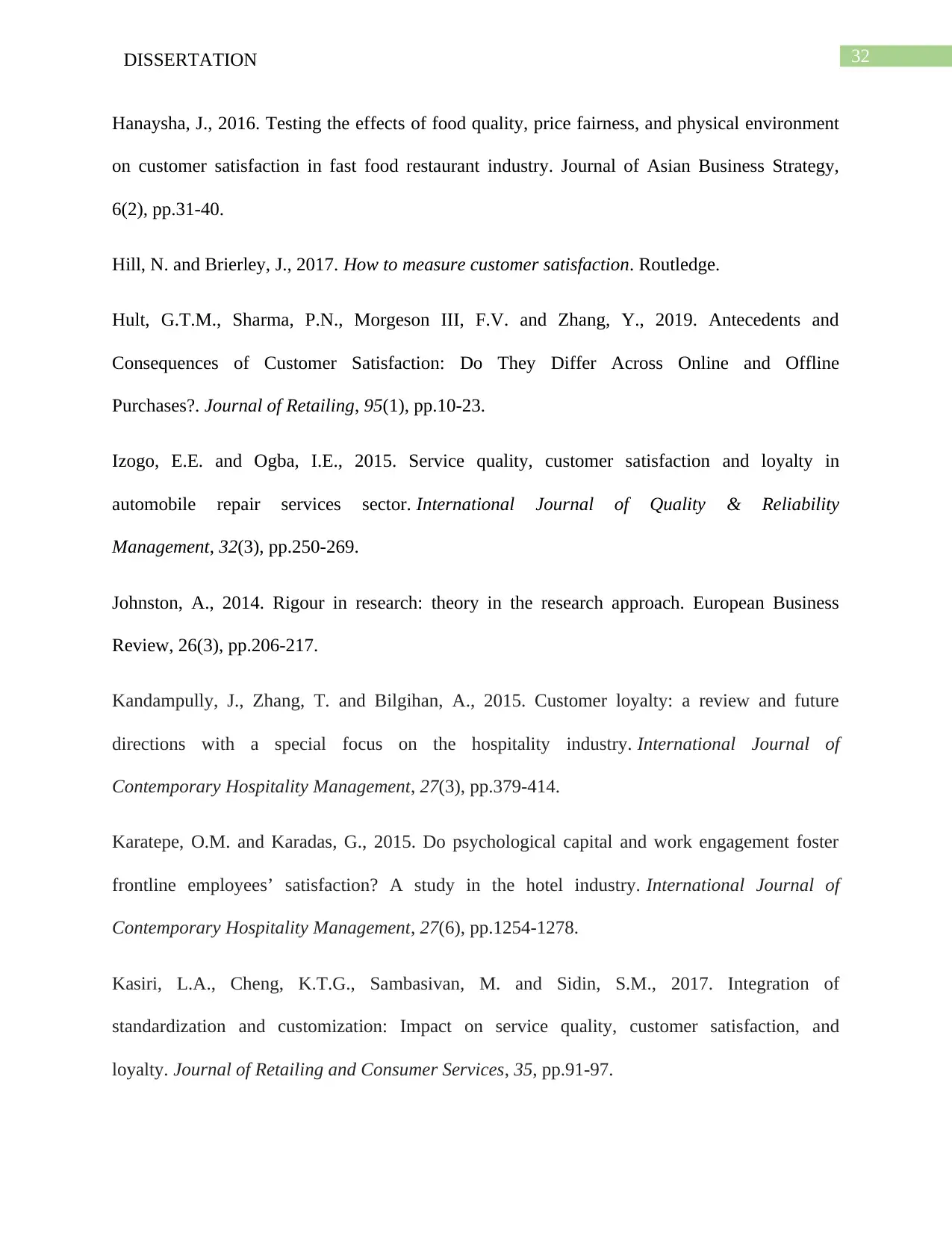
32DISSERTATION
Hanaysha, J., 2016. Testing the effects of food quality, price fairness, and physical environment
on customer satisfaction in fast food restaurant industry. Journal of Asian Business Strategy,
6(2), pp.31-40.
Hill, N. and Brierley, J., 2017. How to measure customer satisfaction. Routledge.
Hult, G.T.M., Sharma, P.N., Morgeson III, F.V. and Zhang, Y., 2019. Antecedents and
Consequences of Customer Satisfaction: Do They Differ Across Online and Offline
Purchases?. Journal of Retailing, 95(1), pp.10-23.
Izogo, E.E. and Ogba, I.E., 2015. Service quality, customer satisfaction and loyalty in
automobile repair services sector. International Journal of Quality & Reliability
Management, 32(3), pp.250-269.
Johnston, A., 2014. Rigour in research: theory in the research approach. European Business
Review, 26(3), pp.206-217.
Kandampully, J., Zhang, T. and Bilgihan, A., 2015. Customer loyalty: a review and future
directions with a special focus on the hospitality industry. International Journal of
Contemporary Hospitality Management, 27(3), pp.379-414.
Karatepe, O.M. and Karadas, G., 2015. Do psychological capital and work engagement foster
frontline employees’ satisfaction? A study in the hotel industry. International Journal of
Contemporary Hospitality Management, 27(6), pp.1254-1278.
Kasiri, L.A., Cheng, K.T.G., Sambasivan, M. and Sidin, S.M., 2017. Integration of
standardization and customization: Impact on service quality, customer satisfaction, and
loyalty. Journal of Retailing and Consumer Services, 35, pp.91-97.
Hanaysha, J., 2016. Testing the effects of food quality, price fairness, and physical environment
on customer satisfaction in fast food restaurant industry. Journal of Asian Business Strategy,
6(2), pp.31-40.
Hill, N. and Brierley, J., 2017. How to measure customer satisfaction. Routledge.
Hult, G.T.M., Sharma, P.N., Morgeson III, F.V. and Zhang, Y., 2019. Antecedents and
Consequences of Customer Satisfaction: Do They Differ Across Online and Offline
Purchases?. Journal of Retailing, 95(1), pp.10-23.
Izogo, E.E. and Ogba, I.E., 2015. Service quality, customer satisfaction and loyalty in
automobile repair services sector. International Journal of Quality & Reliability
Management, 32(3), pp.250-269.
Johnston, A., 2014. Rigour in research: theory in the research approach. European Business
Review, 26(3), pp.206-217.
Kandampully, J., Zhang, T. and Bilgihan, A., 2015. Customer loyalty: a review and future
directions with a special focus on the hospitality industry. International Journal of
Contemporary Hospitality Management, 27(3), pp.379-414.
Karatepe, O.M. and Karadas, G., 2015. Do psychological capital and work engagement foster
frontline employees’ satisfaction? A study in the hotel industry. International Journal of
Contemporary Hospitality Management, 27(6), pp.1254-1278.
Kasiri, L.A., Cheng, K.T.G., Sambasivan, M. and Sidin, S.M., 2017. Integration of
standardization and customization: Impact on service quality, customer satisfaction, and
loyalty. Journal of Retailing and Consumer Services, 35, pp.91-97.
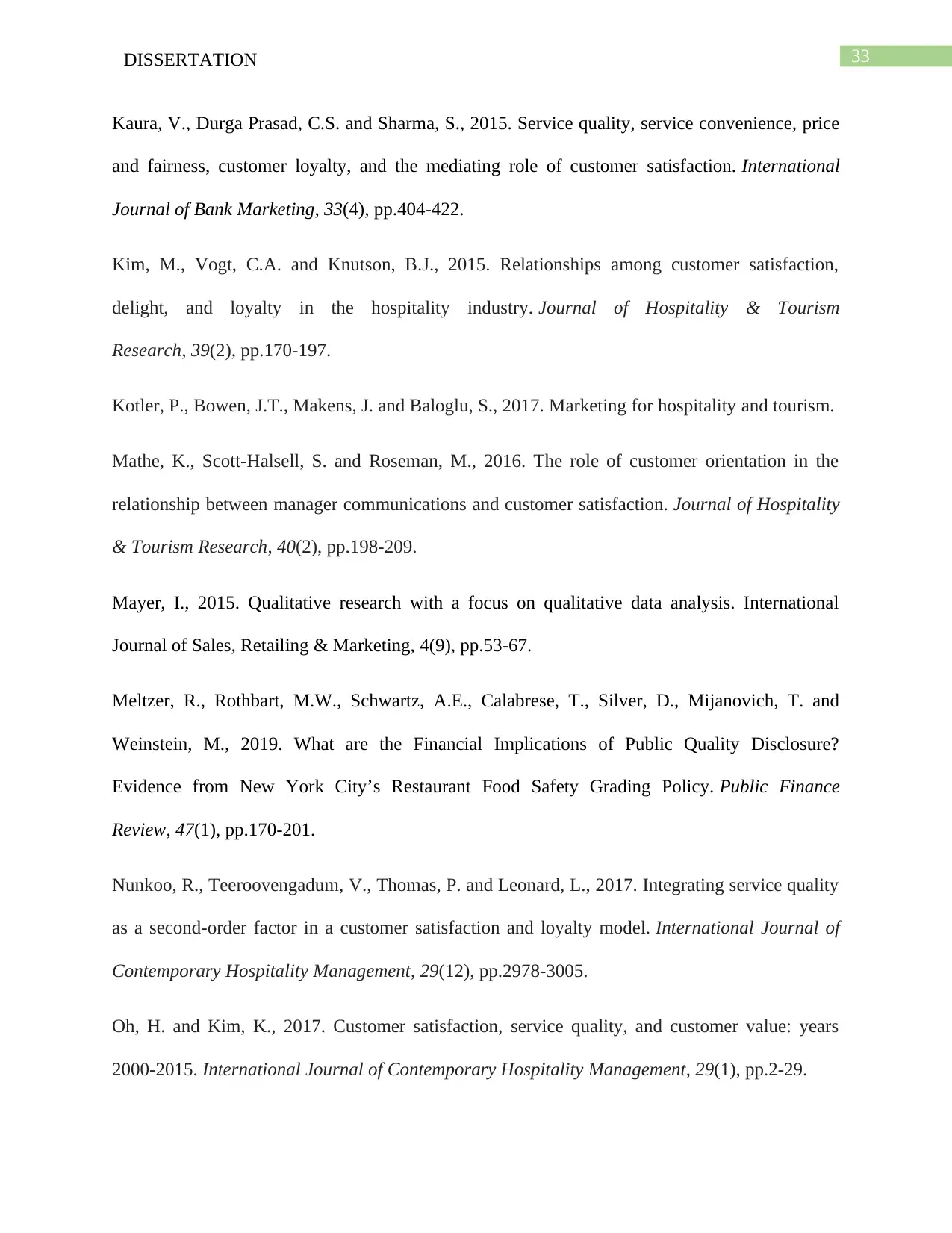
33DISSERTATION
Kaura, V., Durga Prasad, C.S. and Sharma, S., 2015. Service quality, service convenience, price
and fairness, customer loyalty, and the mediating role of customer satisfaction. International
Journal of Bank Marketing, 33(4), pp.404-422.
Kim, M., Vogt, C.A. and Knutson, B.J., 2015. Relationships among customer satisfaction,
delight, and loyalty in the hospitality industry. Journal of Hospitality & Tourism
Research, 39(2), pp.170-197.
Kotler, P., Bowen, J.T., Makens, J. and Baloglu, S., 2017. Marketing for hospitality and tourism.
Mathe, K., Scott-Halsell, S. and Roseman, M., 2016. The role of customer orientation in the
relationship between manager communications and customer satisfaction. Journal of Hospitality
& Tourism Research, 40(2), pp.198-209.
Mayer, I., 2015. Qualitative research with a focus on qualitative data analysis. International
Journal of Sales, Retailing & Marketing, 4(9), pp.53-67.
Meltzer, R., Rothbart, M.W., Schwartz, A.E., Calabrese, T., Silver, D., Mijanovich, T. and
Weinstein, M., 2019. What are the Financial Implications of Public Quality Disclosure?
Evidence from New York City’s Restaurant Food Safety Grading Policy. Public Finance
Review, 47(1), pp.170-201.
Nunkoo, R., Teeroovengadum, V., Thomas, P. and Leonard, L., 2017. Integrating service quality
as a second-order factor in a customer satisfaction and loyalty model. International Journal of
Contemporary Hospitality Management, 29(12), pp.2978-3005.
Oh, H. and Kim, K., 2017. Customer satisfaction, service quality, and customer value: years
2000-2015. International Journal of Contemporary Hospitality Management, 29(1), pp.2-29.
Kaura, V., Durga Prasad, C.S. and Sharma, S., 2015. Service quality, service convenience, price
and fairness, customer loyalty, and the mediating role of customer satisfaction. International
Journal of Bank Marketing, 33(4), pp.404-422.
Kim, M., Vogt, C.A. and Knutson, B.J., 2015. Relationships among customer satisfaction,
delight, and loyalty in the hospitality industry. Journal of Hospitality & Tourism
Research, 39(2), pp.170-197.
Kotler, P., Bowen, J.T., Makens, J. and Baloglu, S., 2017. Marketing for hospitality and tourism.
Mathe, K., Scott-Halsell, S. and Roseman, M., 2016. The role of customer orientation in the
relationship between manager communications and customer satisfaction. Journal of Hospitality
& Tourism Research, 40(2), pp.198-209.
Mayer, I., 2015. Qualitative research with a focus on qualitative data analysis. International
Journal of Sales, Retailing & Marketing, 4(9), pp.53-67.
Meltzer, R., Rothbart, M.W., Schwartz, A.E., Calabrese, T., Silver, D., Mijanovich, T. and
Weinstein, M., 2019. What are the Financial Implications of Public Quality Disclosure?
Evidence from New York City’s Restaurant Food Safety Grading Policy. Public Finance
Review, 47(1), pp.170-201.
Nunkoo, R., Teeroovengadum, V., Thomas, P. and Leonard, L., 2017. Integrating service quality
as a second-order factor in a customer satisfaction and loyalty model. International Journal of
Contemporary Hospitality Management, 29(12), pp.2978-3005.
Oh, H. and Kim, K., 2017. Customer satisfaction, service quality, and customer value: years
2000-2015. International Journal of Contemporary Hospitality Management, 29(1), pp.2-29.
Secure Best Marks with AI Grader
Need help grading? Try our AI Grader for instant feedback on your assignments.
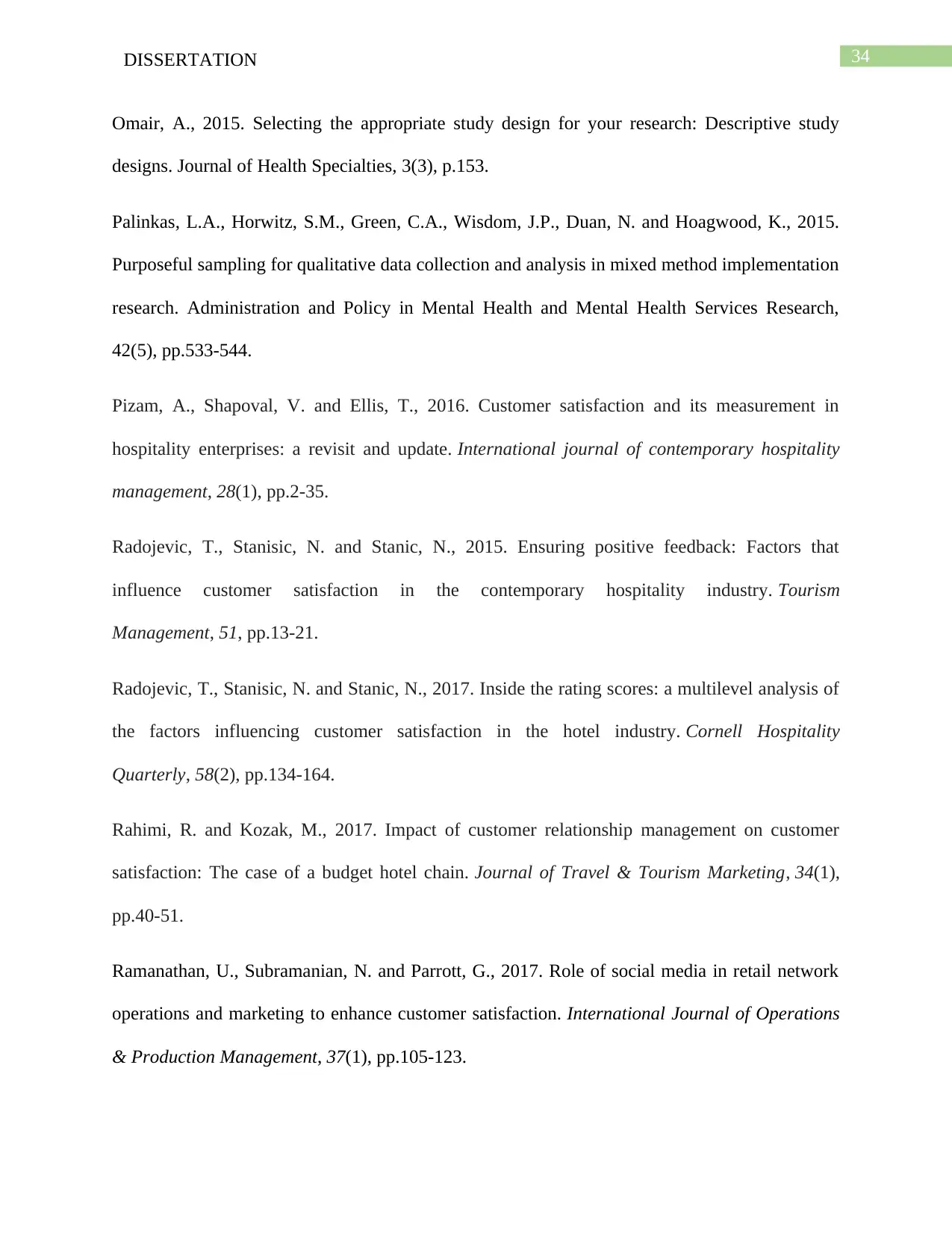
34DISSERTATION
Omair, A., 2015. Selecting the appropriate study design for your research: Descriptive study
designs. Journal of Health Specialties, 3(3), p.153.
Palinkas, L.A., Horwitz, S.M., Green, C.A., Wisdom, J.P., Duan, N. and Hoagwood, K., 2015.
Purposeful sampling for qualitative data collection and analysis in mixed method implementation
research. Administration and Policy in Mental Health and Mental Health Services Research,
42(5), pp.533-544.
Pizam, A., Shapoval, V. and Ellis, T., 2016. Customer satisfaction and its measurement in
hospitality enterprises: a revisit and update. International journal of contemporary hospitality
management, 28(1), pp.2-35.
Radojevic, T., Stanisic, N. and Stanic, N., 2015. Ensuring positive feedback: Factors that
influence customer satisfaction in the contemporary hospitality industry. Tourism
Management, 51, pp.13-21.
Radojevic, T., Stanisic, N. and Stanic, N., 2017. Inside the rating scores: a multilevel analysis of
the factors influencing customer satisfaction in the hotel industry. Cornell Hospitality
Quarterly, 58(2), pp.134-164.
Rahimi, R. and Kozak, M., 2017. Impact of customer relationship management on customer
satisfaction: The case of a budget hotel chain. Journal of Travel & Tourism Marketing, 34(1),
pp.40-51.
Ramanathan, U., Subramanian, N. and Parrott, G., 2017. Role of social media in retail network
operations and marketing to enhance customer satisfaction. International Journal of Operations
& Production Management, 37(1), pp.105-123.
Omair, A., 2015. Selecting the appropriate study design for your research: Descriptive study
designs. Journal of Health Specialties, 3(3), p.153.
Palinkas, L.A., Horwitz, S.M., Green, C.A., Wisdom, J.P., Duan, N. and Hoagwood, K., 2015.
Purposeful sampling for qualitative data collection and analysis in mixed method implementation
research. Administration and Policy in Mental Health and Mental Health Services Research,
42(5), pp.533-544.
Pizam, A., Shapoval, V. and Ellis, T., 2016. Customer satisfaction and its measurement in
hospitality enterprises: a revisit and update. International journal of contemporary hospitality
management, 28(1), pp.2-35.
Radojevic, T., Stanisic, N. and Stanic, N., 2015. Ensuring positive feedback: Factors that
influence customer satisfaction in the contemporary hospitality industry. Tourism
Management, 51, pp.13-21.
Radojevic, T., Stanisic, N. and Stanic, N., 2017. Inside the rating scores: a multilevel analysis of
the factors influencing customer satisfaction in the hotel industry. Cornell Hospitality
Quarterly, 58(2), pp.134-164.
Rahimi, R. and Kozak, M., 2017. Impact of customer relationship management on customer
satisfaction: The case of a budget hotel chain. Journal of Travel & Tourism Marketing, 34(1),
pp.40-51.
Ramanathan, U., Subramanian, N. and Parrott, G., 2017. Role of social media in retail network
operations and marketing to enhance customer satisfaction. International Journal of Operations
& Production Management, 37(1), pp.105-123.
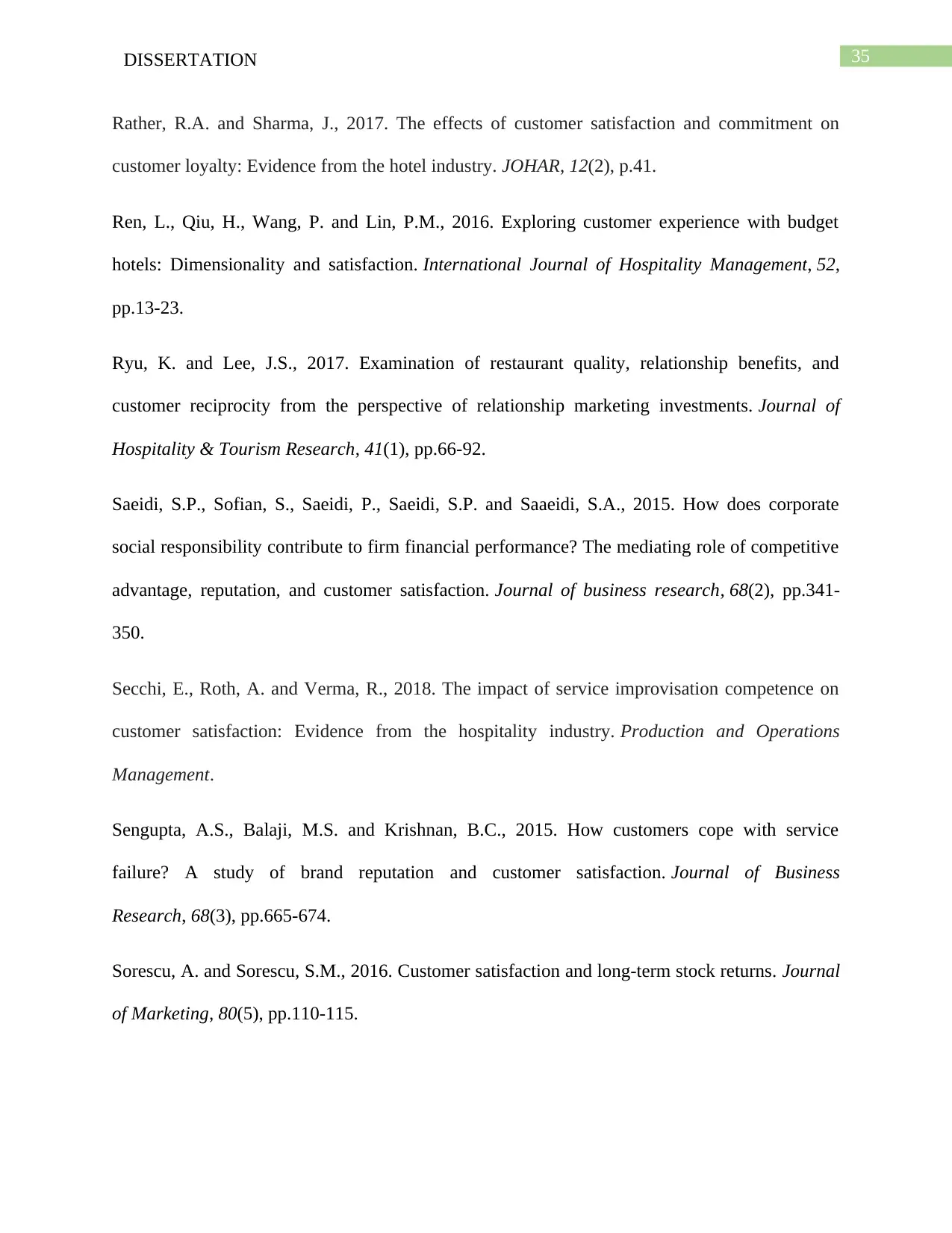
35DISSERTATION
Rather, R.A. and Sharma, J., 2017. The effects of customer satisfaction and commitment on
customer loyalty: Evidence from the hotel industry. JOHAR, 12(2), p.41.
Ren, L., Qiu, H., Wang, P. and Lin, P.M., 2016. Exploring customer experience with budget
hotels: Dimensionality and satisfaction. International Journal of Hospitality Management, 52,
pp.13-23.
Ryu, K. and Lee, J.S., 2017. Examination of restaurant quality, relationship benefits, and
customer reciprocity from the perspective of relationship marketing investments. Journal of
Hospitality & Tourism Research, 41(1), pp.66-92.
Saeidi, S.P., Sofian, S., Saeidi, P., Saeidi, S.P. and Saaeidi, S.A., 2015. How does corporate
social responsibility contribute to firm financial performance? The mediating role of competitive
advantage, reputation, and customer satisfaction. Journal of business research, 68(2), pp.341-
350.
Secchi, E., Roth, A. and Verma, R., 2018. The impact of service improvisation competence on
customer satisfaction: Evidence from the hospitality industry. Production and Operations
Management.
Sengupta, A.S., Balaji, M.S. and Krishnan, B.C., 2015. How customers cope with service
failure? A study of brand reputation and customer satisfaction. Journal of Business
Research, 68(3), pp.665-674.
Sorescu, A. and Sorescu, S.M., 2016. Customer satisfaction and long-term stock returns. Journal
of Marketing, 80(5), pp.110-115.
Rather, R.A. and Sharma, J., 2017. The effects of customer satisfaction and commitment on
customer loyalty: Evidence from the hotel industry. JOHAR, 12(2), p.41.
Ren, L., Qiu, H., Wang, P. and Lin, P.M., 2016. Exploring customer experience with budget
hotels: Dimensionality and satisfaction. International Journal of Hospitality Management, 52,
pp.13-23.
Ryu, K. and Lee, J.S., 2017. Examination of restaurant quality, relationship benefits, and
customer reciprocity from the perspective of relationship marketing investments. Journal of
Hospitality & Tourism Research, 41(1), pp.66-92.
Saeidi, S.P., Sofian, S., Saeidi, P., Saeidi, S.P. and Saaeidi, S.A., 2015. How does corporate
social responsibility contribute to firm financial performance? The mediating role of competitive
advantage, reputation, and customer satisfaction. Journal of business research, 68(2), pp.341-
350.
Secchi, E., Roth, A. and Verma, R., 2018. The impact of service improvisation competence on
customer satisfaction: Evidence from the hospitality industry. Production and Operations
Management.
Sengupta, A.S., Balaji, M.S. and Krishnan, B.C., 2015. How customers cope with service
failure? A study of brand reputation and customer satisfaction. Journal of Business
Research, 68(3), pp.665-674.
Sorescu, A. and Sorescu, S.M., 2016. Customer satisfaction and long-term stock returns. Journal
of Marketing, 80(5), pp.110-115.
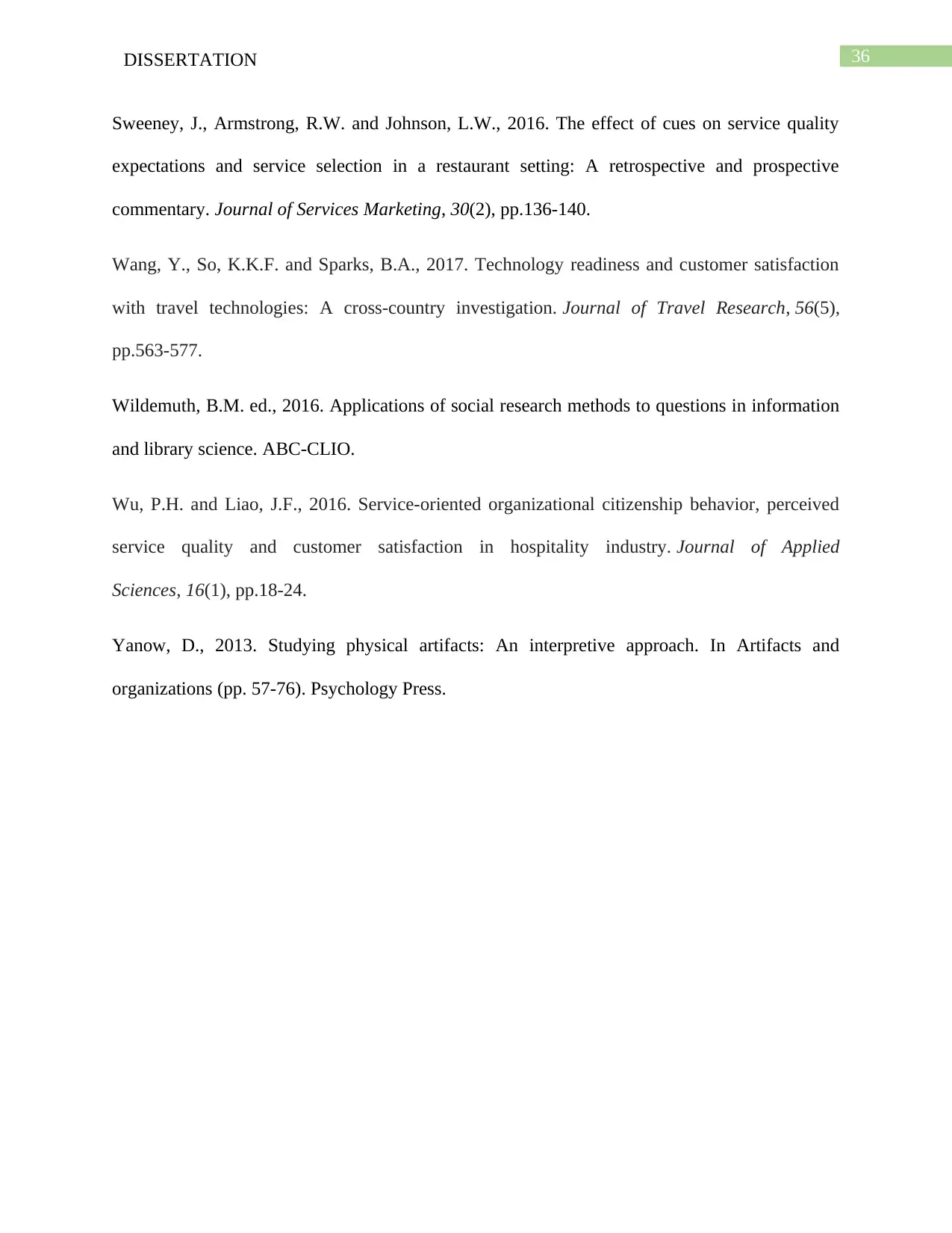
36DISSERTATION
Sweeney, J., Armstrong, R.W. and Johnson, L.W., 2016. The effect of cues on service quality
expectations and service selection in a restaurant setting: A retrospective and prospective
commentary. Journal of Services Marketing, 30(2), pp.136-140.
Wang, Y., So, K.K.F. and Sparks, B.A., 2017. Technology readiness and customer satisfaction
with travel technologies: A cross-country investigation. Journal of Travel Research, 56(5),
pp.563-577.
Wildemuth, B.M. ed., 2016. Applications of social research methods to questions in information
and library science. ABC-CLIO.
Wu, P.H. and Liao, J.F., 2016. Service-oriented organizational citizenship behavior, perceived
service quality and customer satisfaction in hospitality industry. Journal of Applied
Sciences, 16(1), pp.18-24.
Yanow, D., 2013. Studying physical artifacts: An interpretive approach. In Artifacts and
organizations (pp. 57-76). Psychology Press.
Sweeney, J., Armstrong, R.W. and Johnson, L.W., 2016. The effect of cues on service quality
expectations and service selection in a restaurant setting: A retrospective and prospective
commentary. Journal of Services Marketing, 30(2), pp.136-140.
Wang, Y., So, K.K.F. and Sparks, B.A., 2017. Technology readiness and customer satisfaction
with travel technologies: A cross-country investigation. Journal of Travel Research, 56(5),
pp.563-577.
Wildemuth, B.M. ed., 2016. Applications of social research methods to questions in information
and library science. ABC-CLIO.
Wu, P.H. and Liao, J.F., 2016. Service-oriented organizational citizenship behavior, perceived
service quality and customer satisfaction in hospitality industry. Journal of Applied
Sciences, 16(1), pp.18-24.
Yanow, D., 2013. Studying physical artifacts: An interpretive approach. In Artifacts and
organizations (pp. 57-76). Psychology Press.
Paraphrase This Document
Need a fresh take? Get an instant paraphrase of this document with our AI Paraphraser
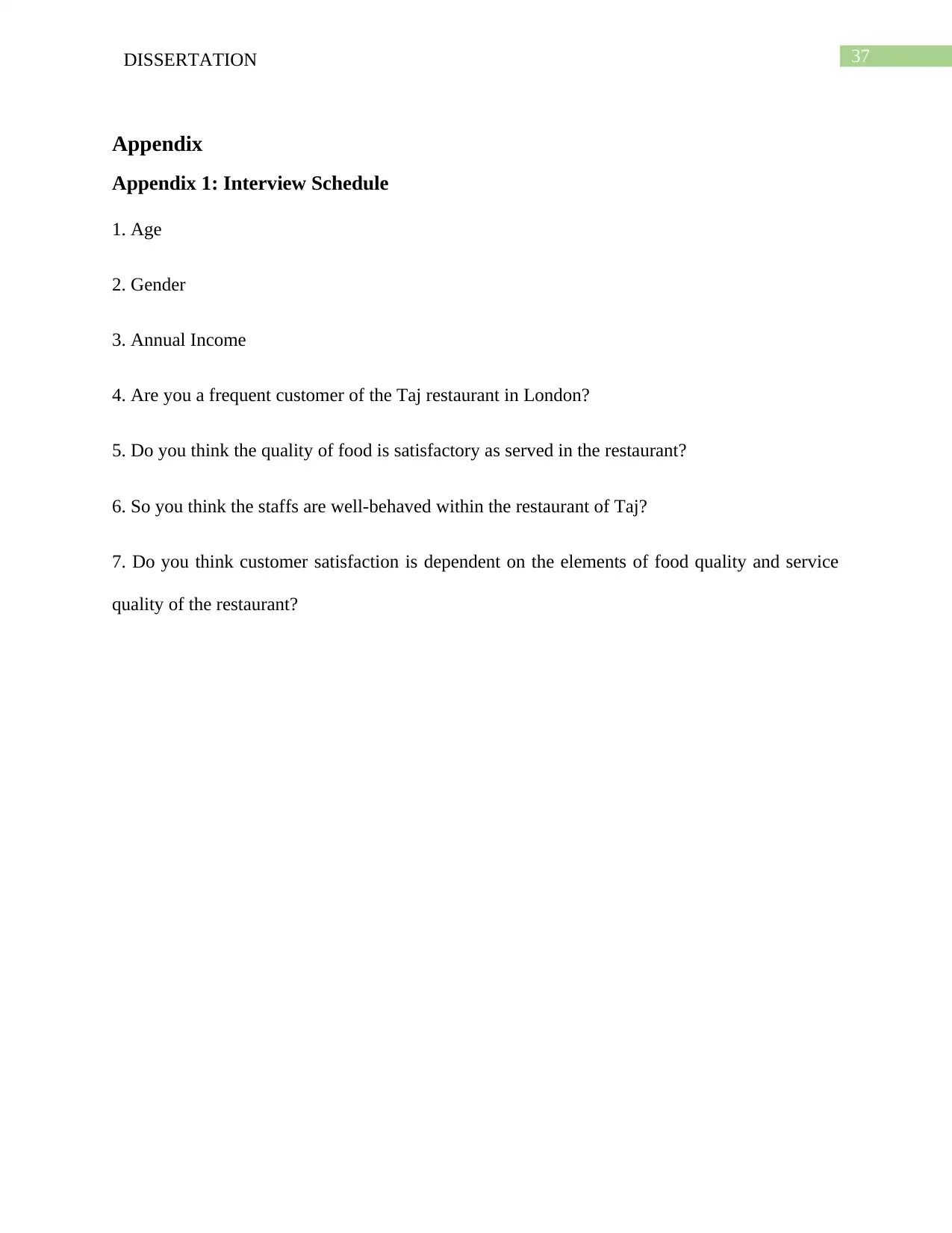
37DISSERTATION
Appendix
Appendix 1: Interview Schedule
1. Age
2. Gender
3. Annual Income
4. Are you a frequent customer of the Taj restaurant in London?
5. Do you think the quality of food is satisfactory as served in the restaurant?
6. So you think the staffs are well-behaved within the restaurant of Taj?
7. Do you think customer satisfaction is dependent on the elements of food quality and service
quality of the restaurant?
Appendix
Appendix 1: Interview Schedule
1. Age
2. Gender
3. Annual Income
4. Are you a frequent customer of the Taj restaurant in London?
5. Do you think the quality of food is satisfactory as served in the restaurant?
6. So you think the staffs are well-behaved within the restaurant of Taj?
7. Do you think customer satisfaction is dependent on the elements of food quality and service
quality of the restaurant?
1 out of 38
Related Documents
Your All-in-One AI-Powered Toolkit for Academic Success.
+13062052269
info@desklib.com
Available 24*7 on WhatsApp / Email
![[object Object]](/_next/static/media/star-bottom.7253800d.svg)
Unlock your academic potential
© 2024 | Zucol Services PVT LTD | All rights reserved.





